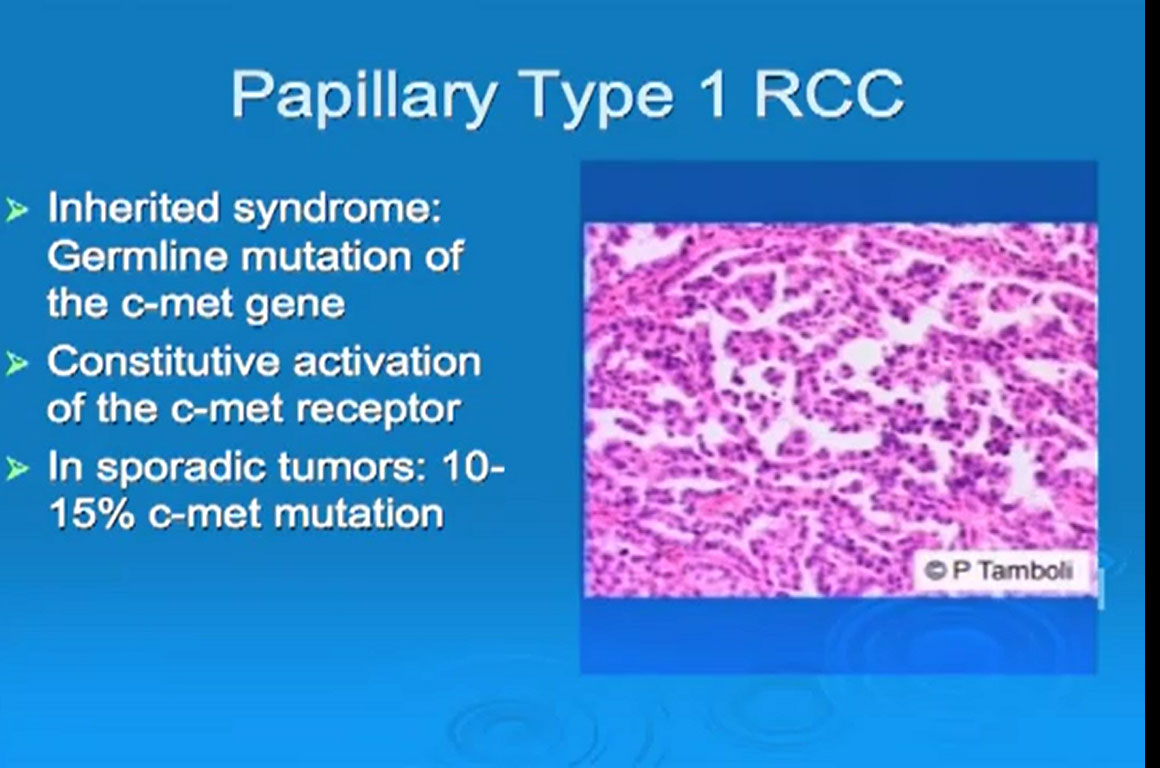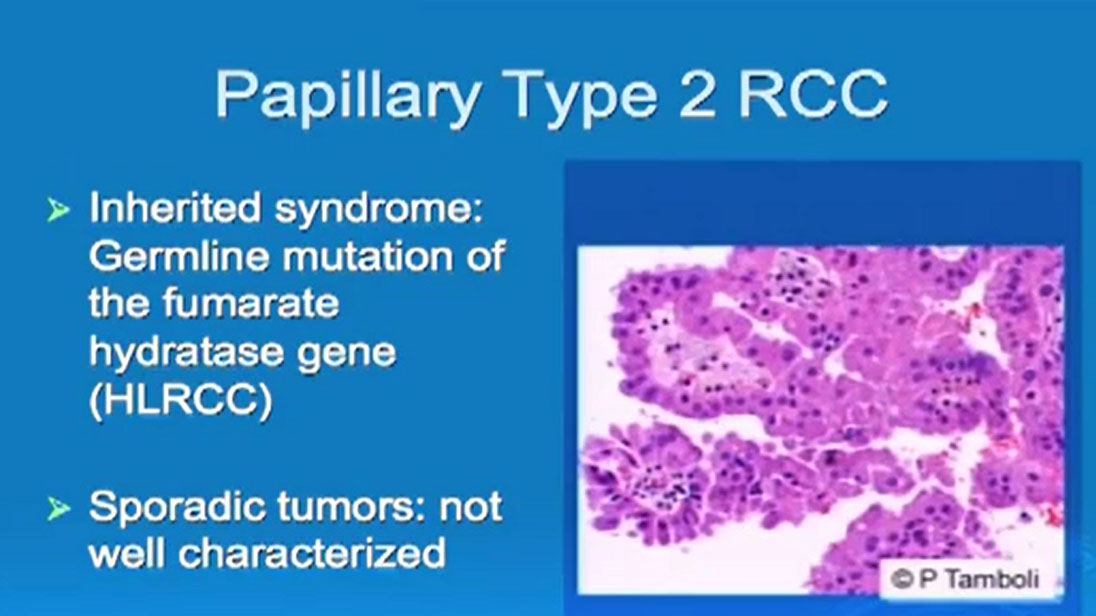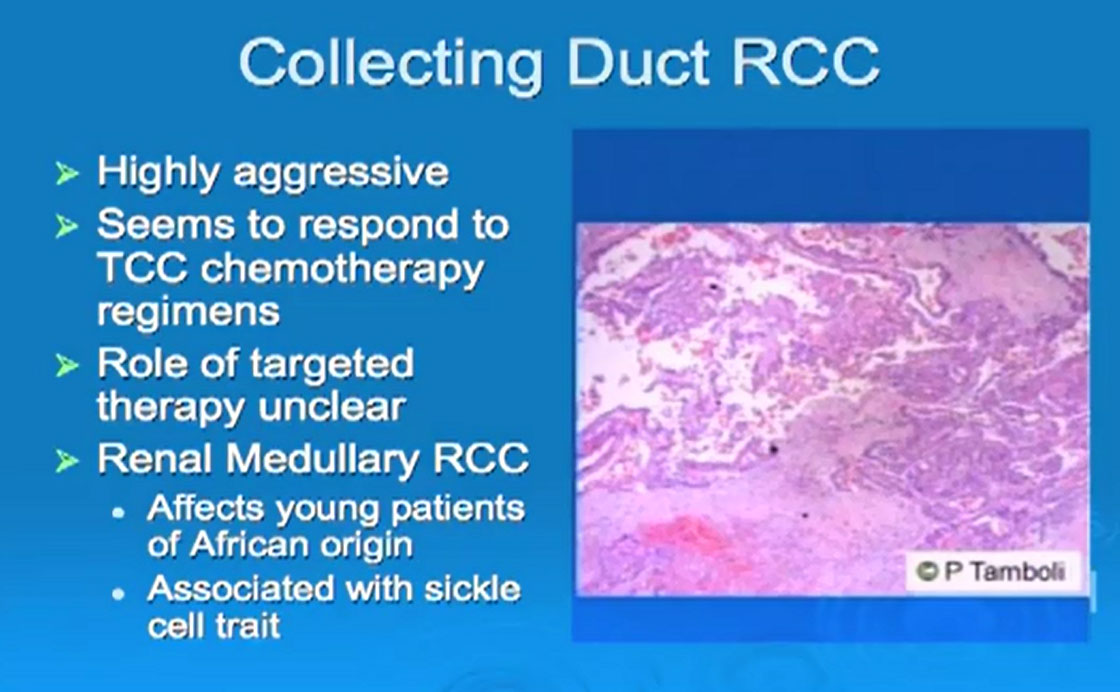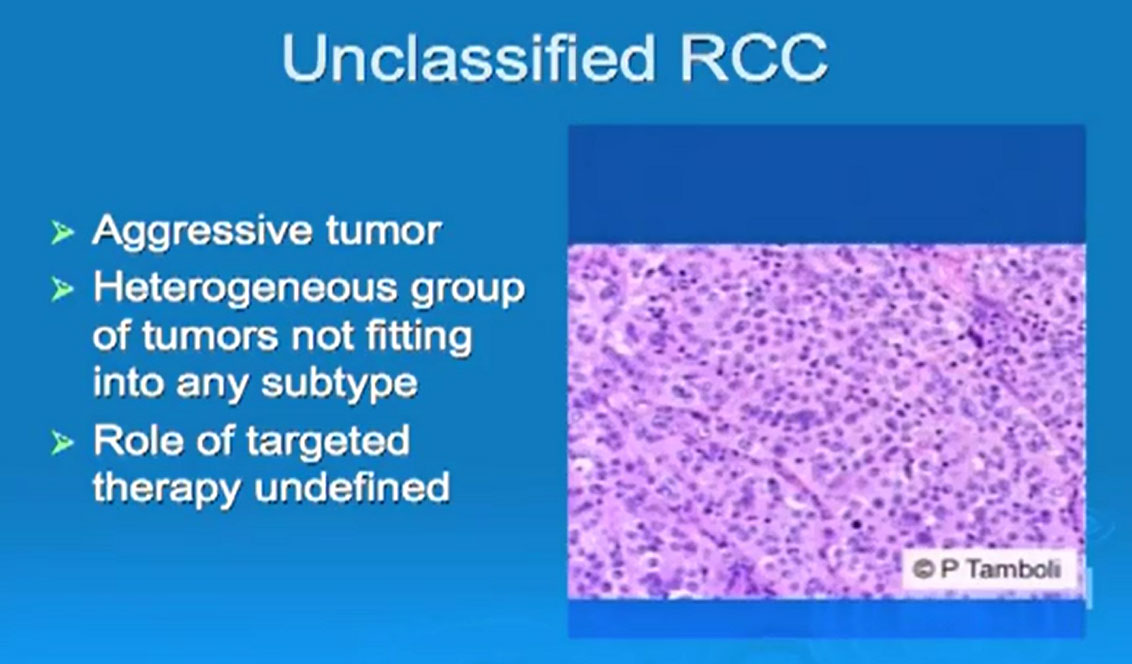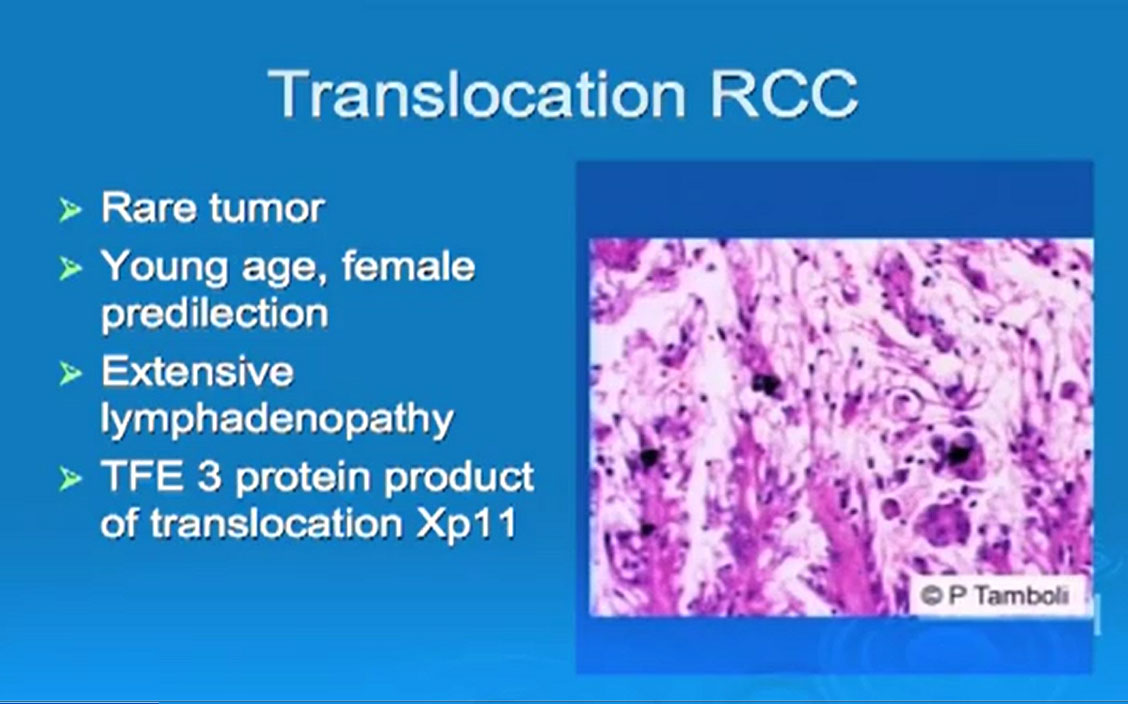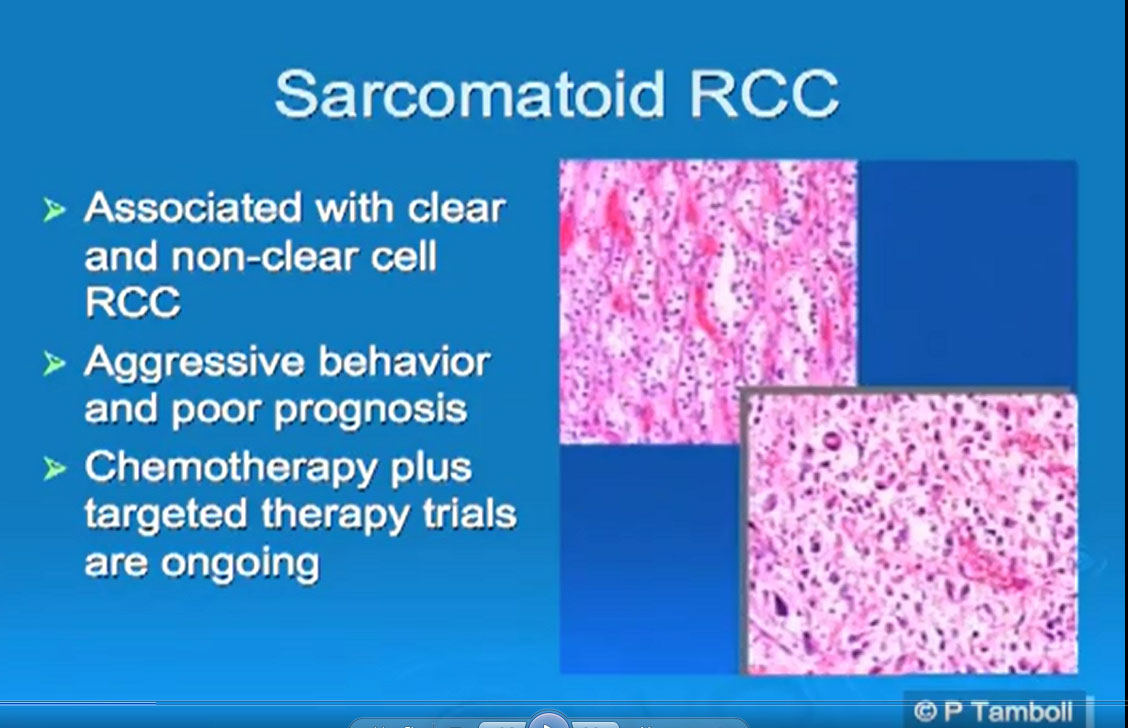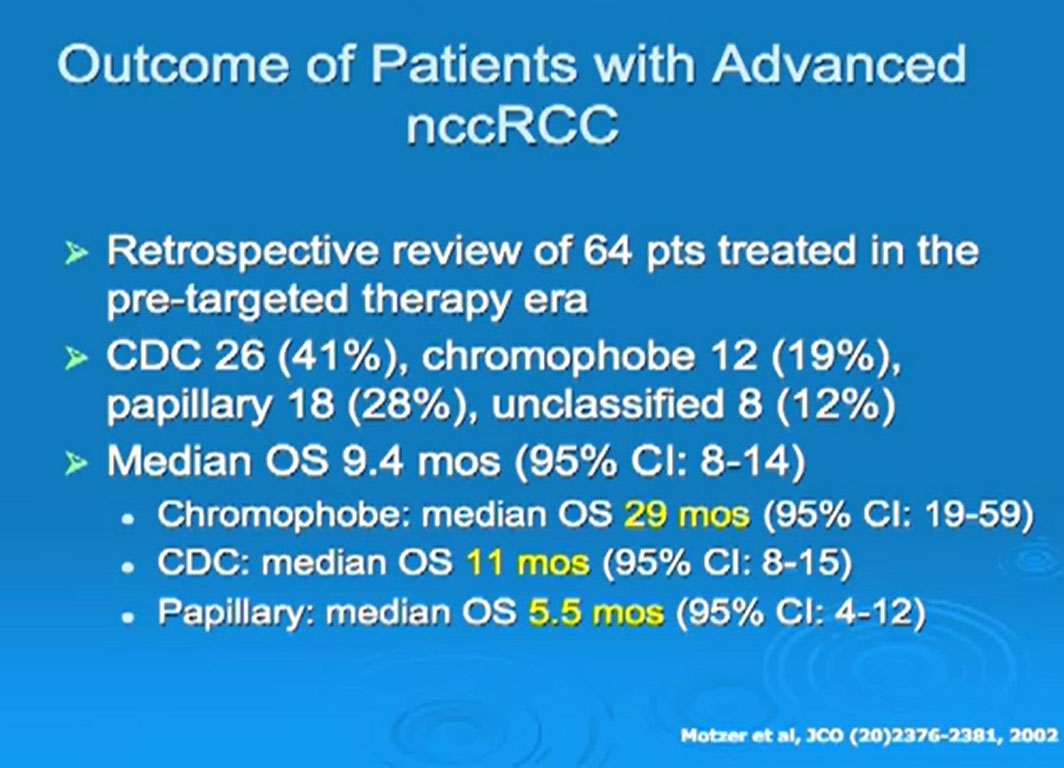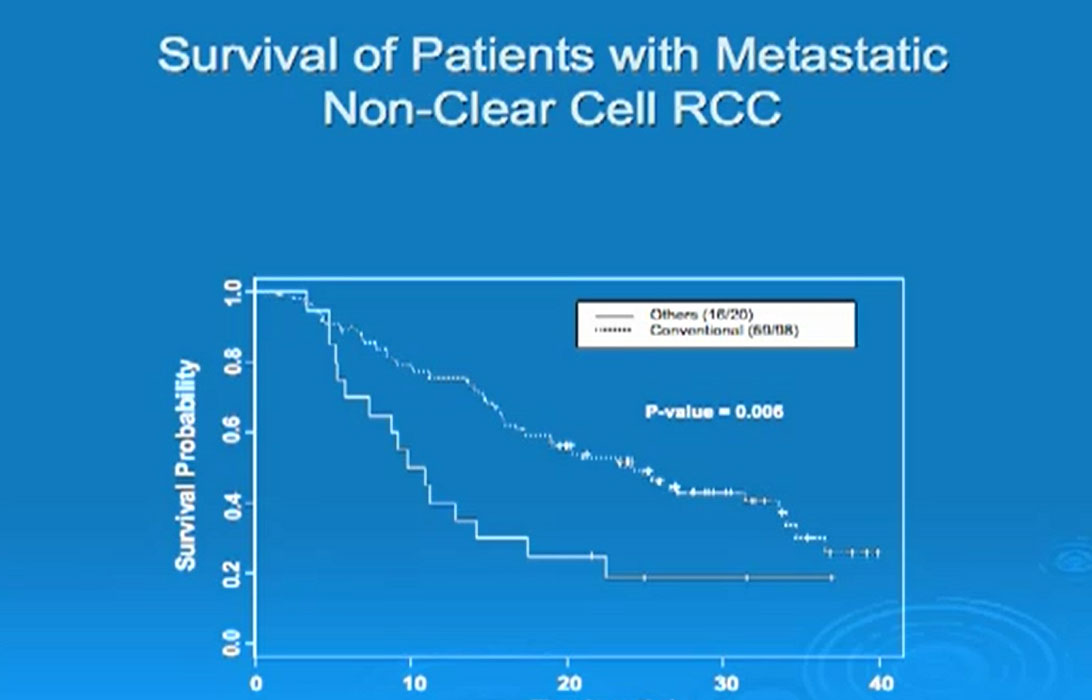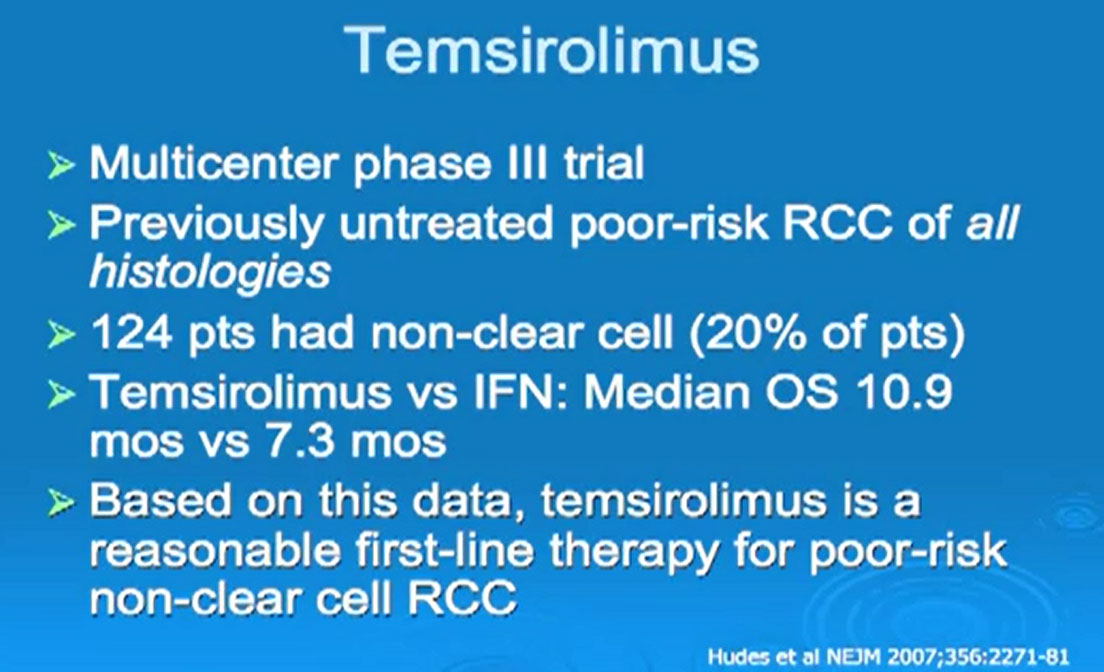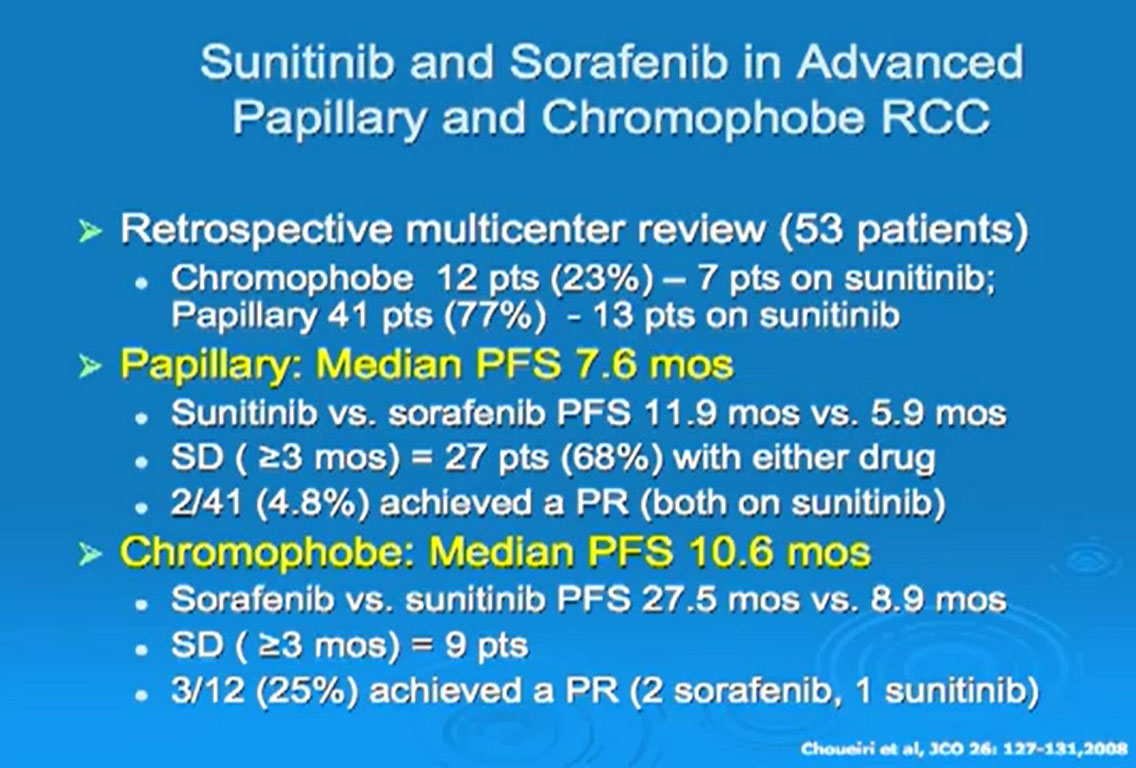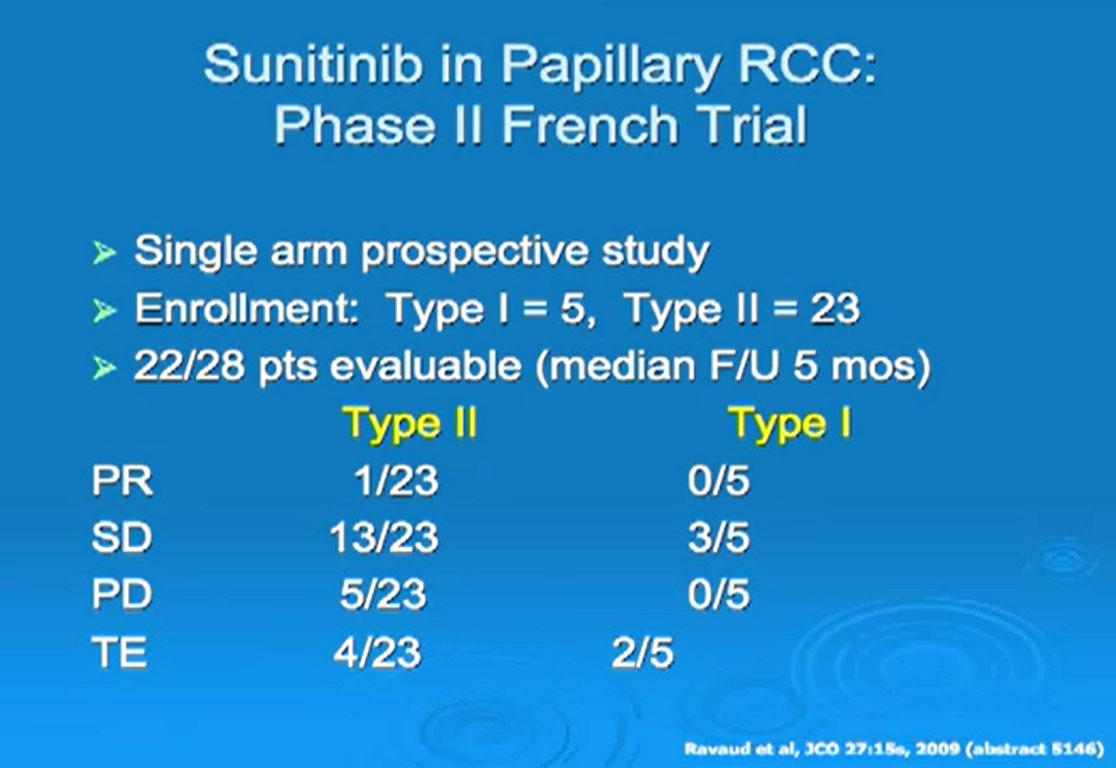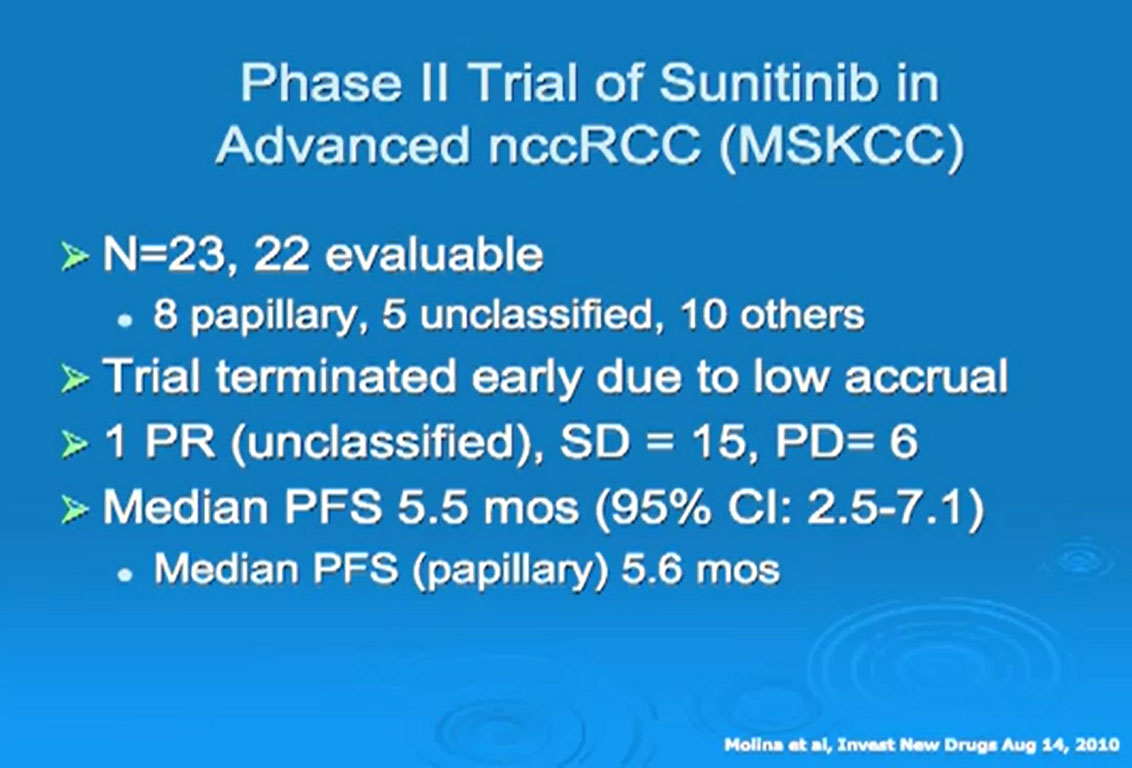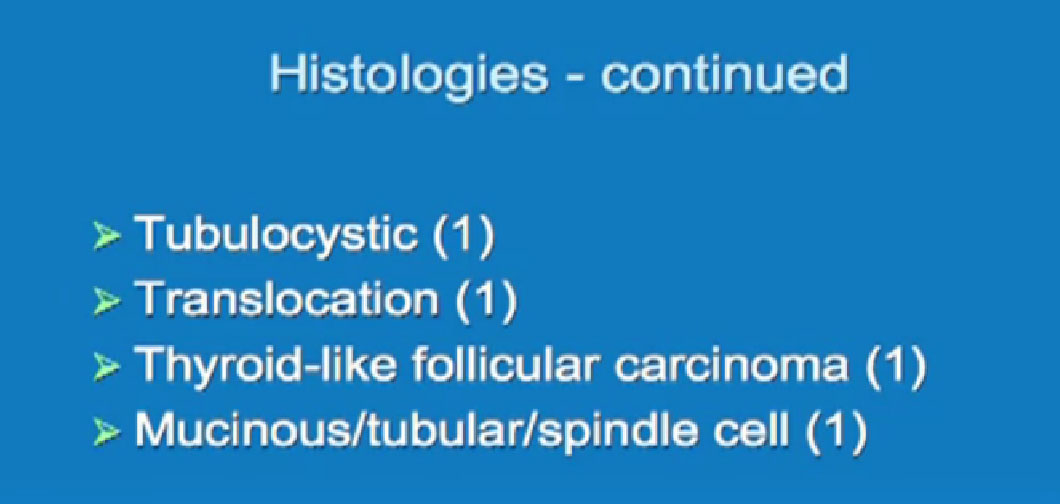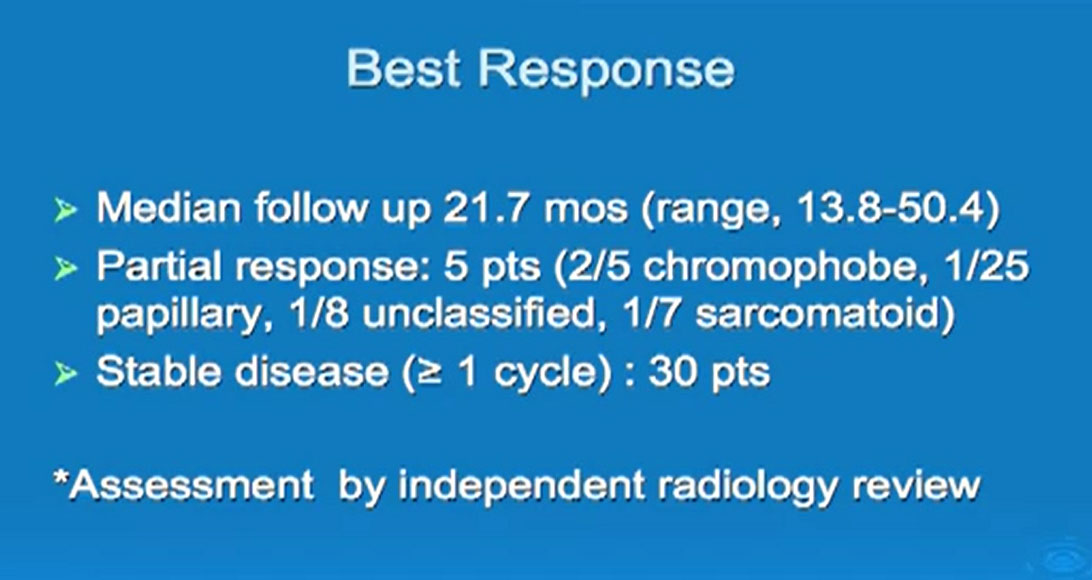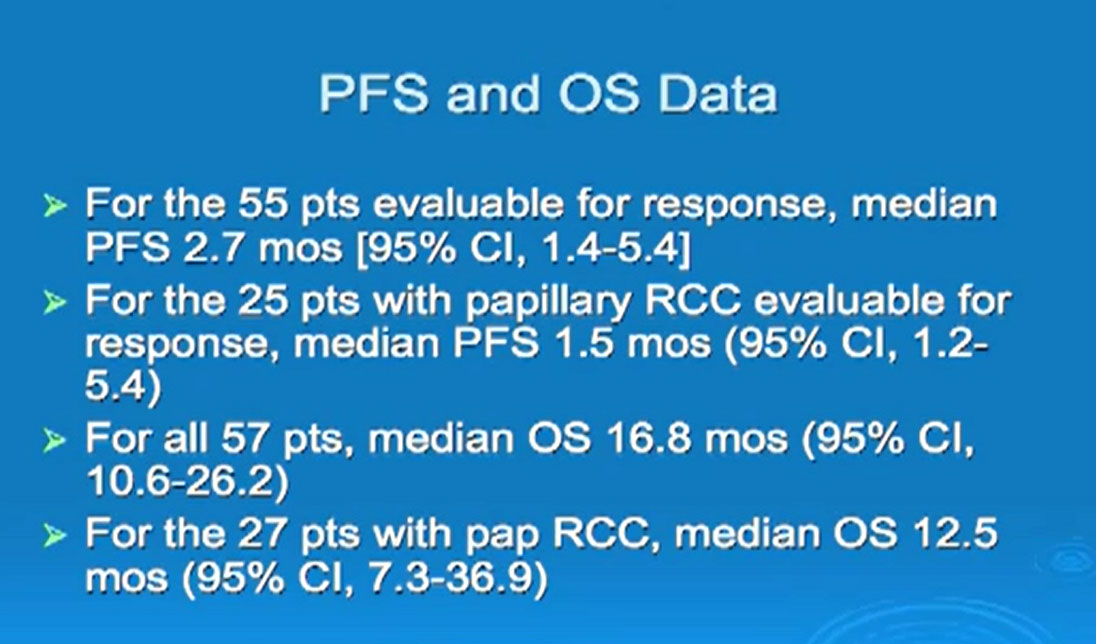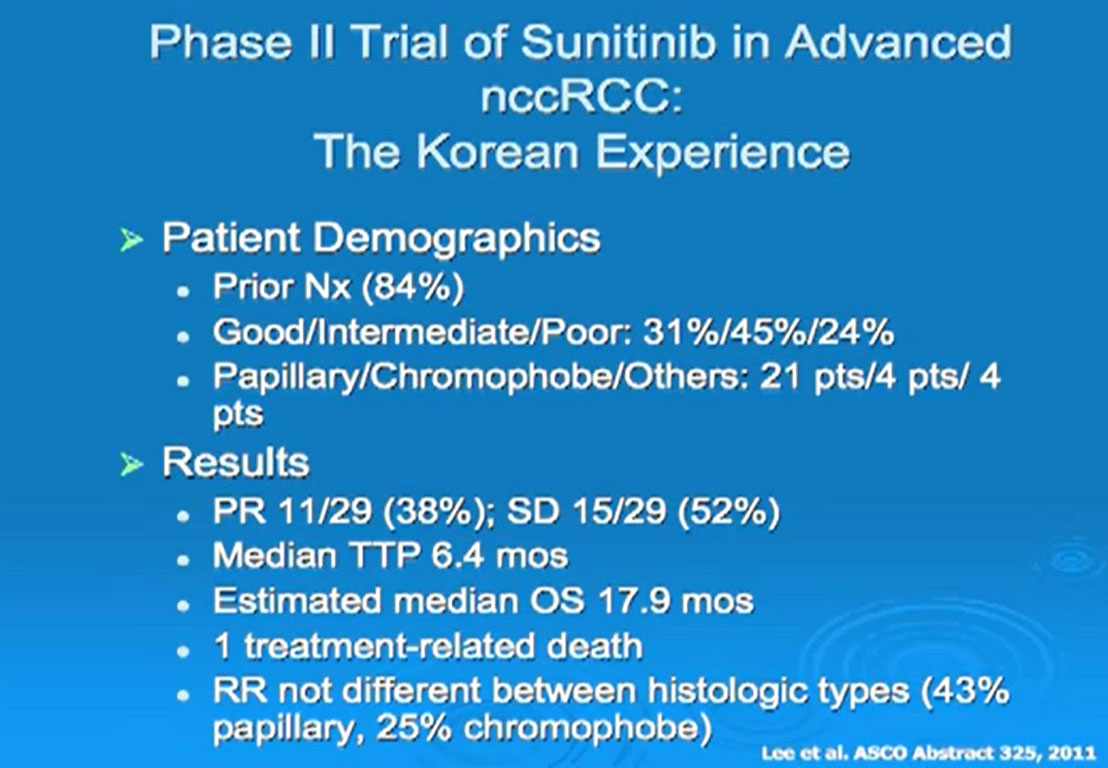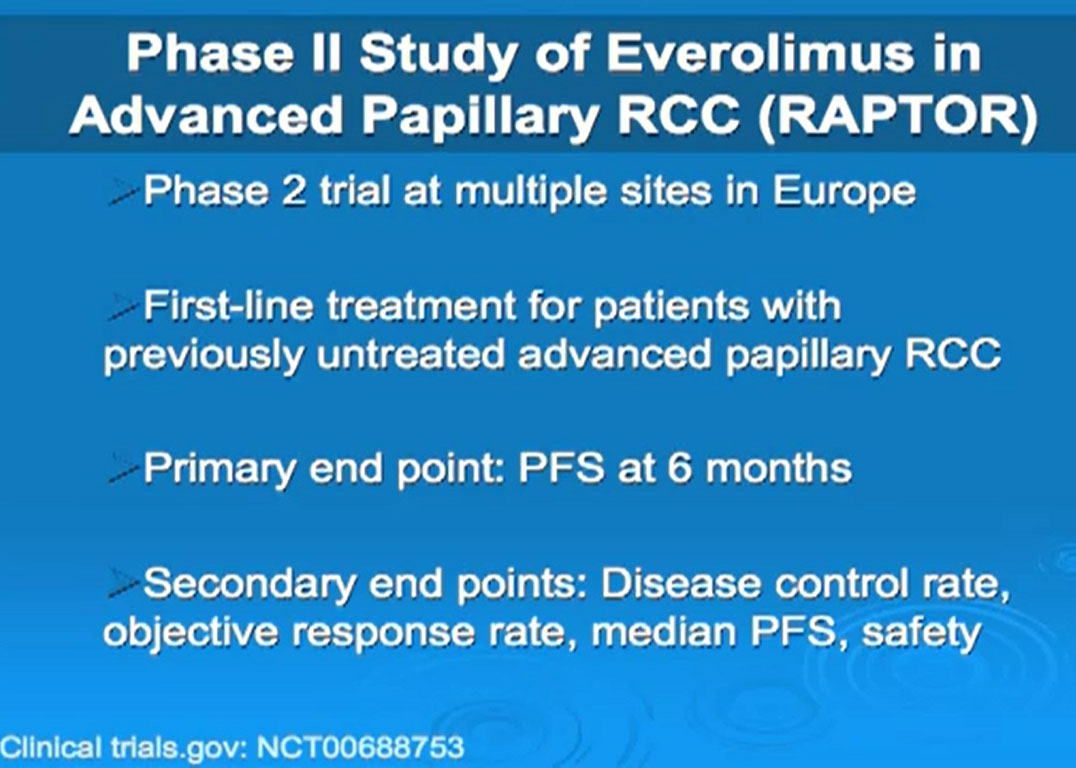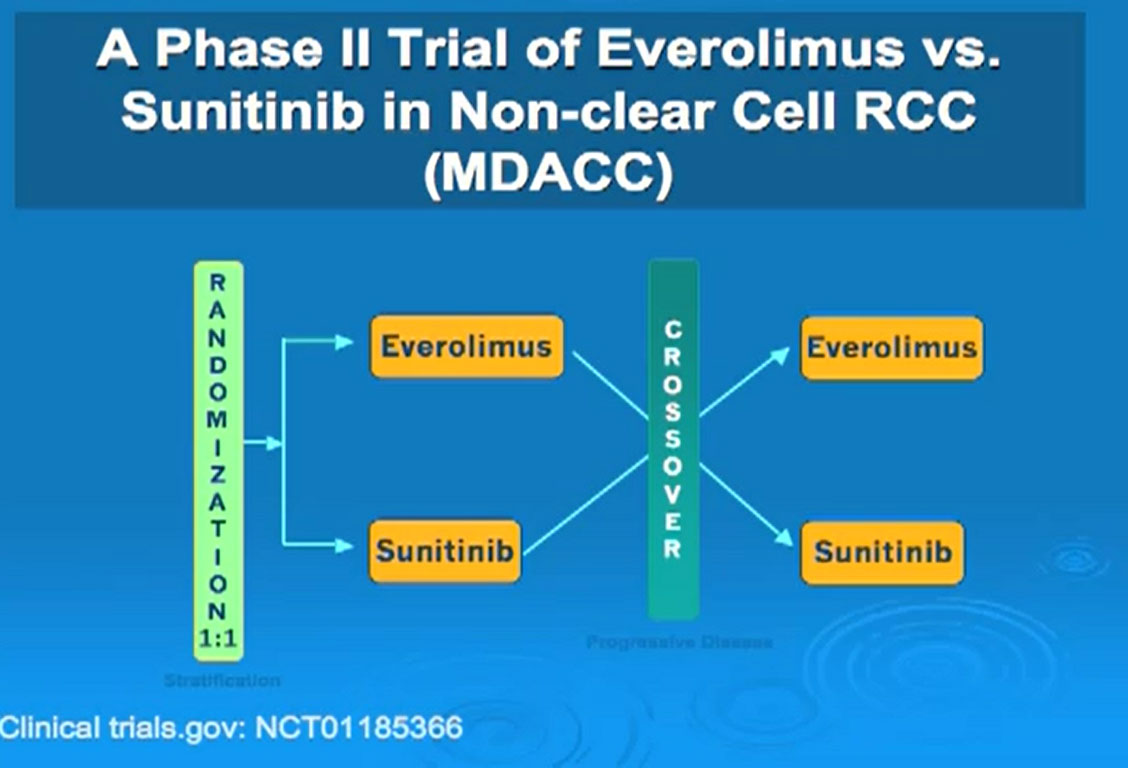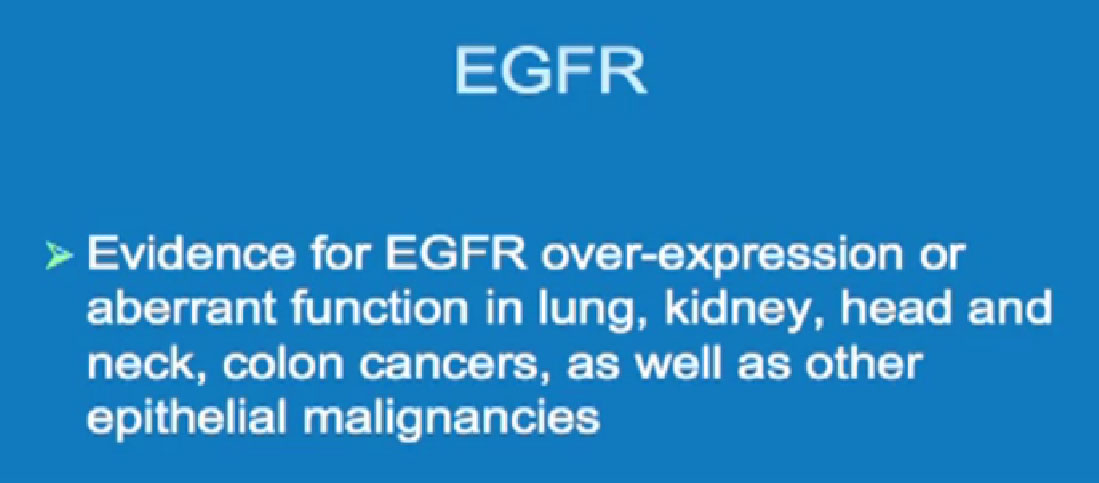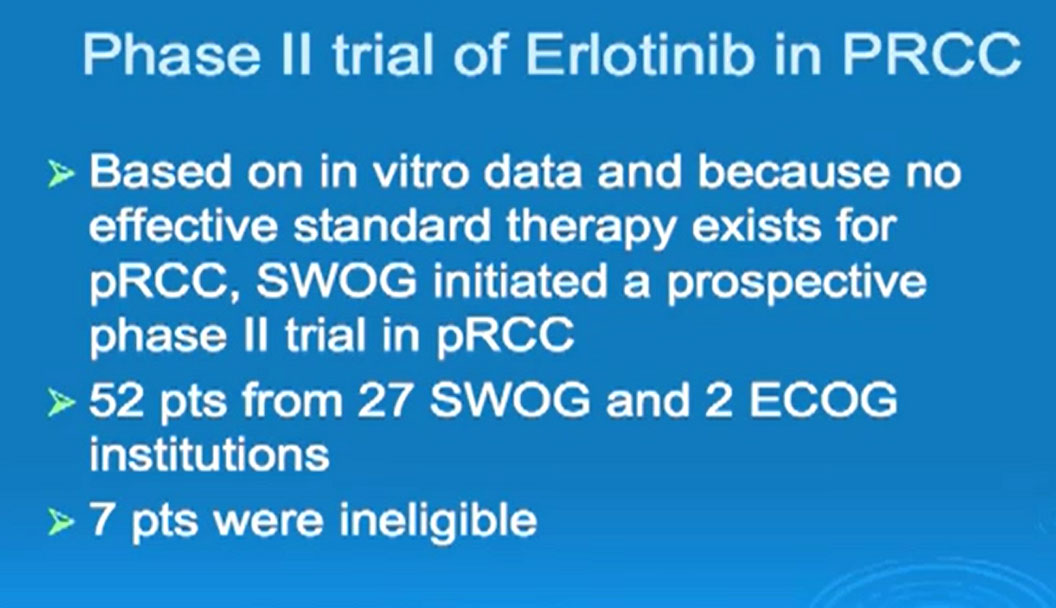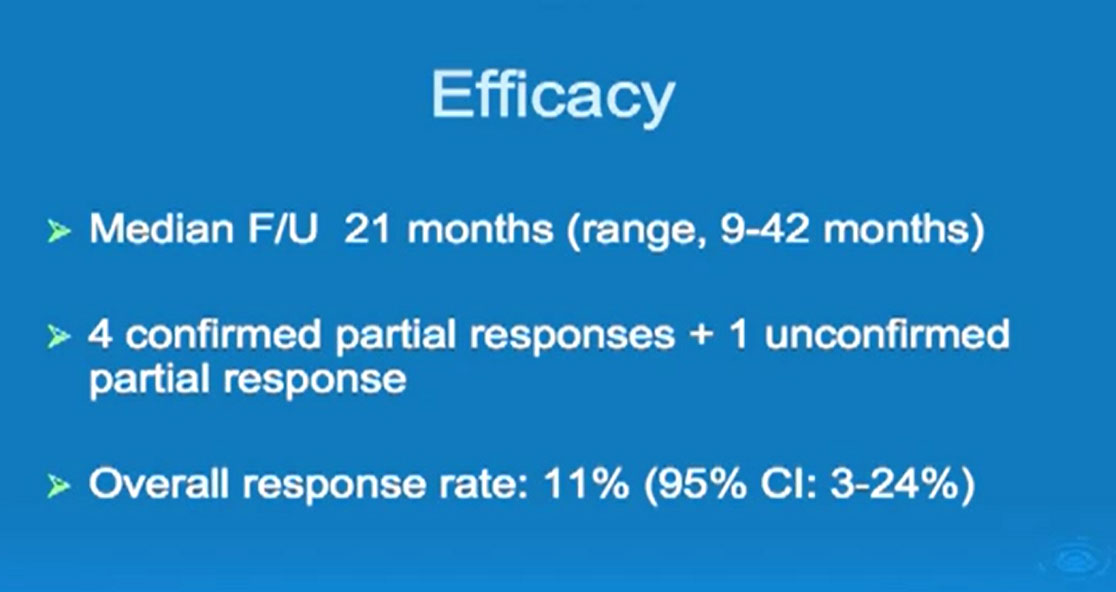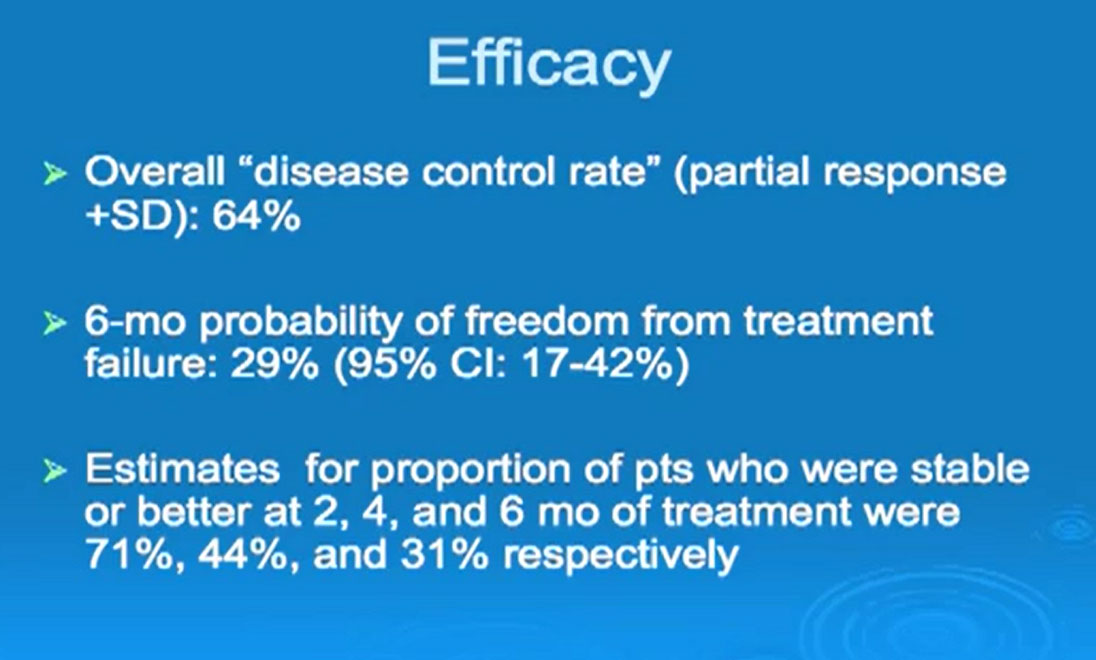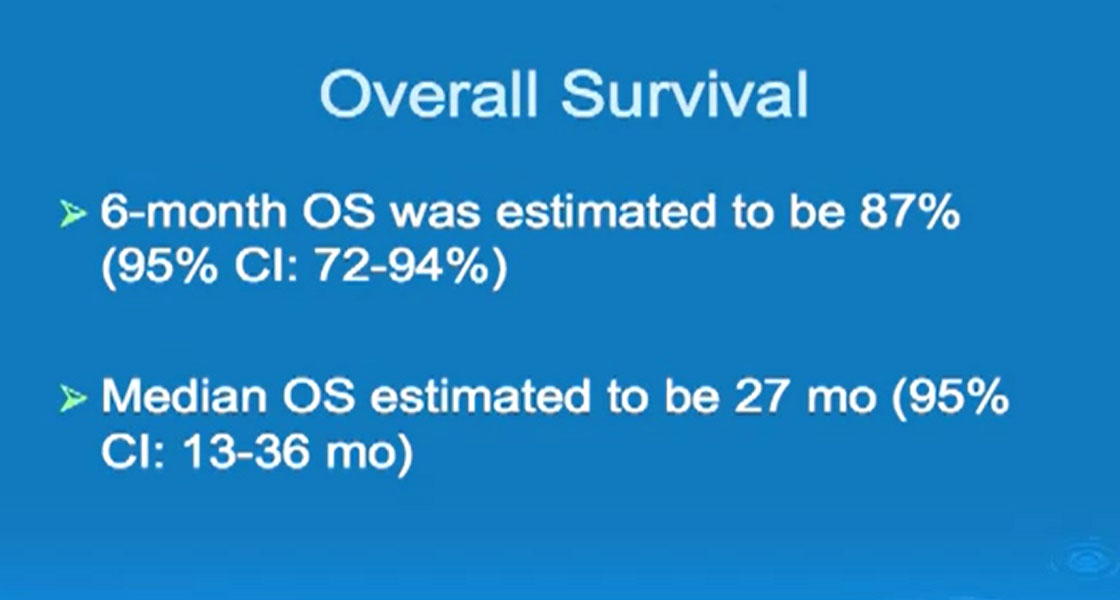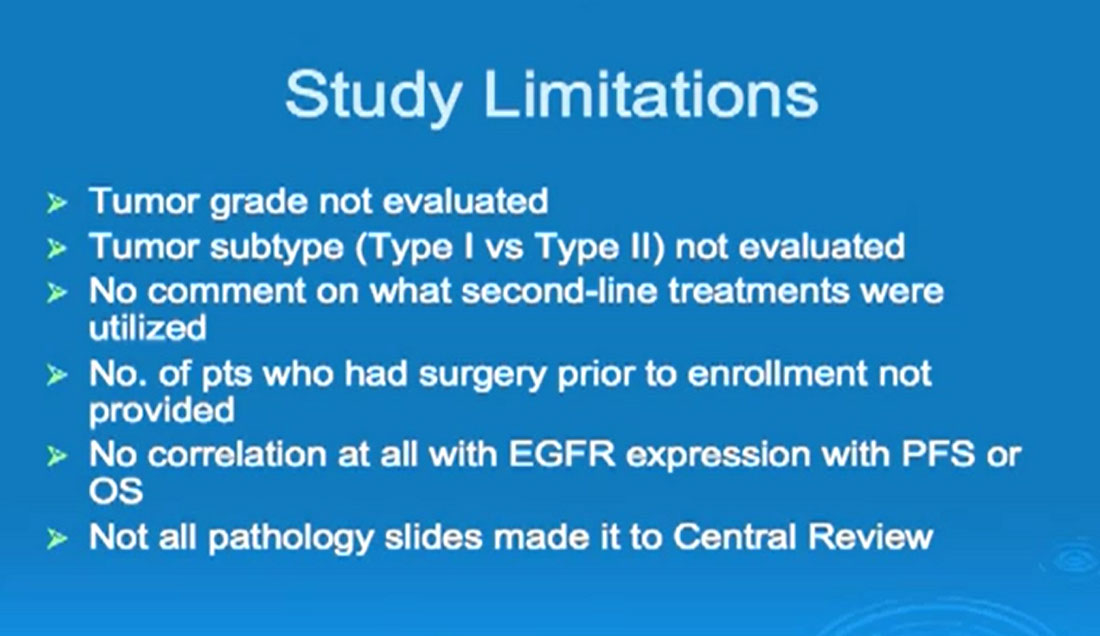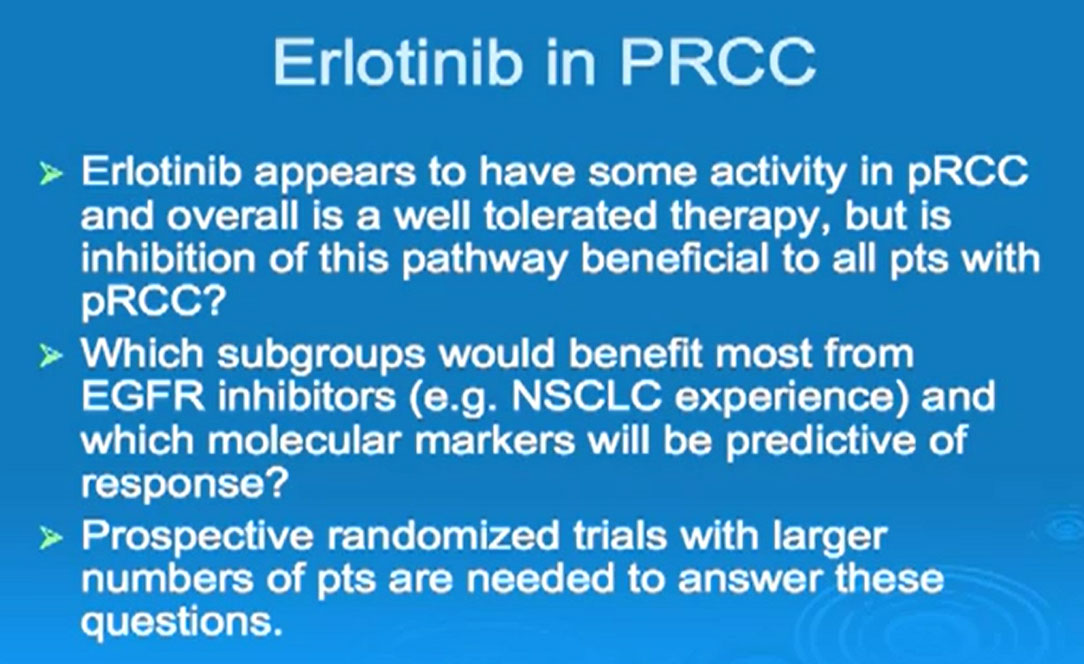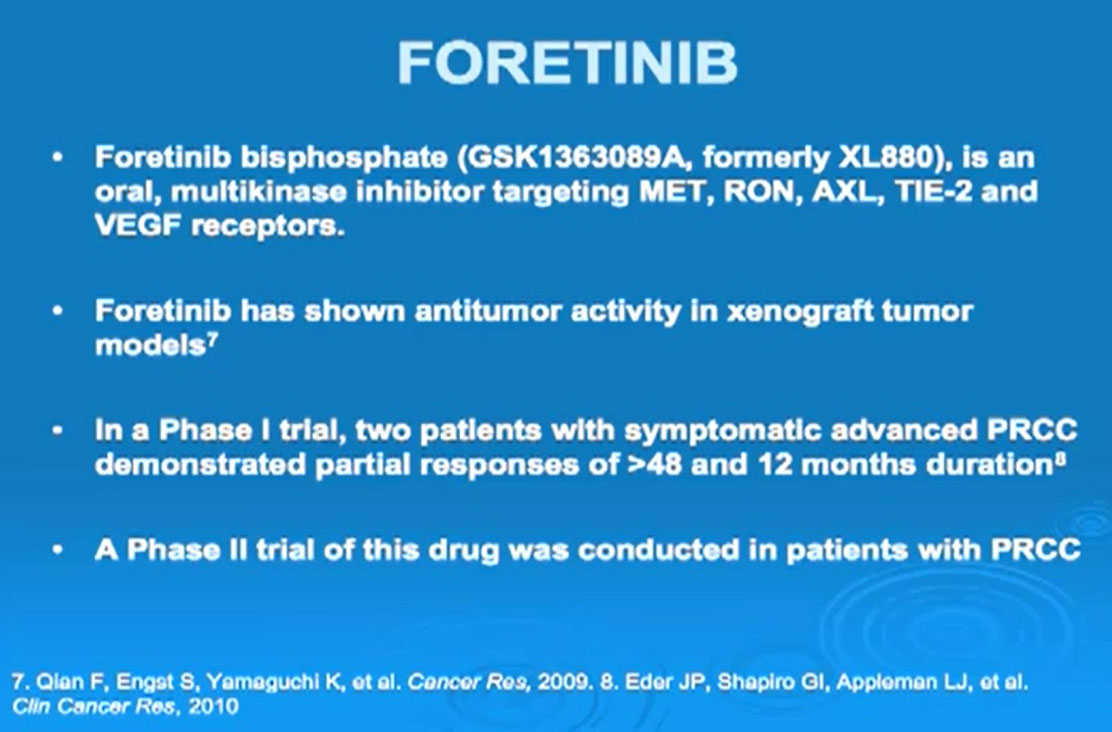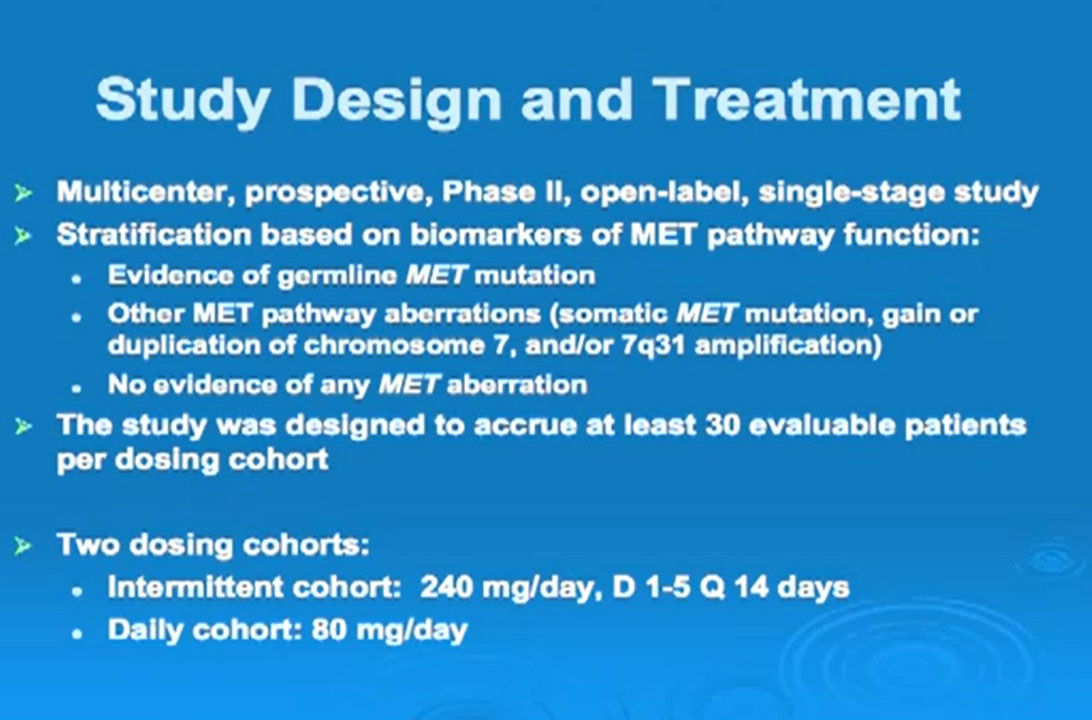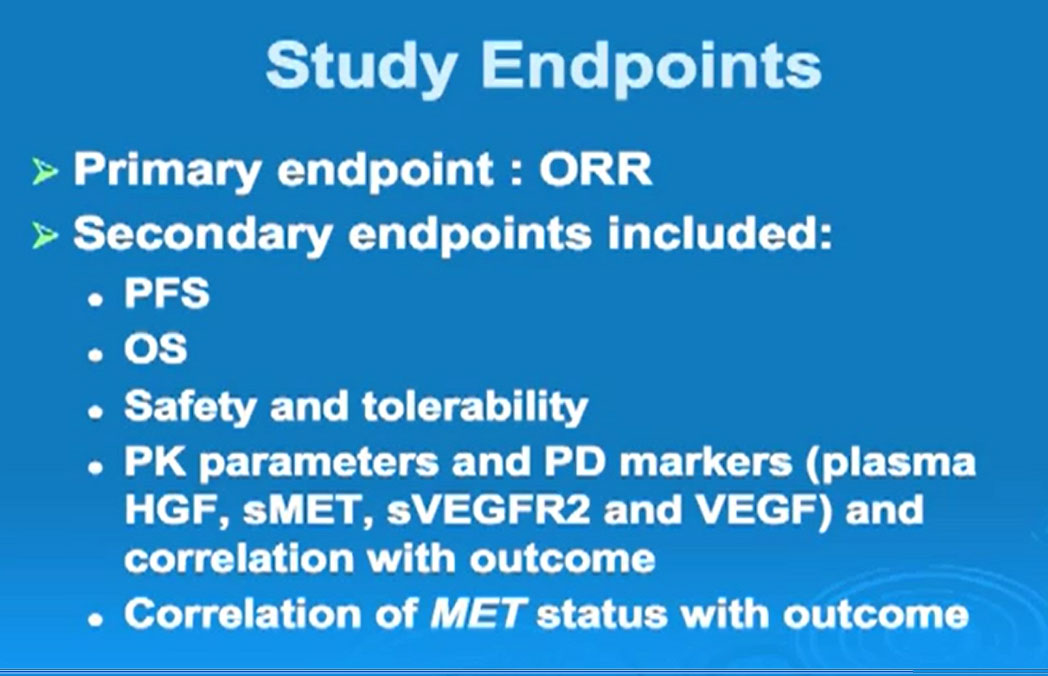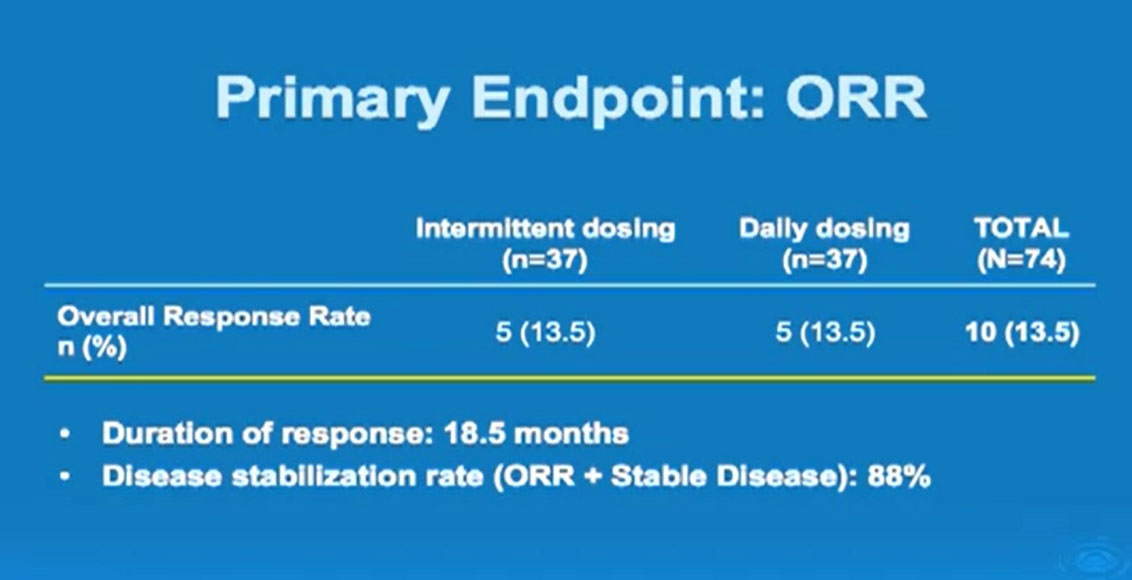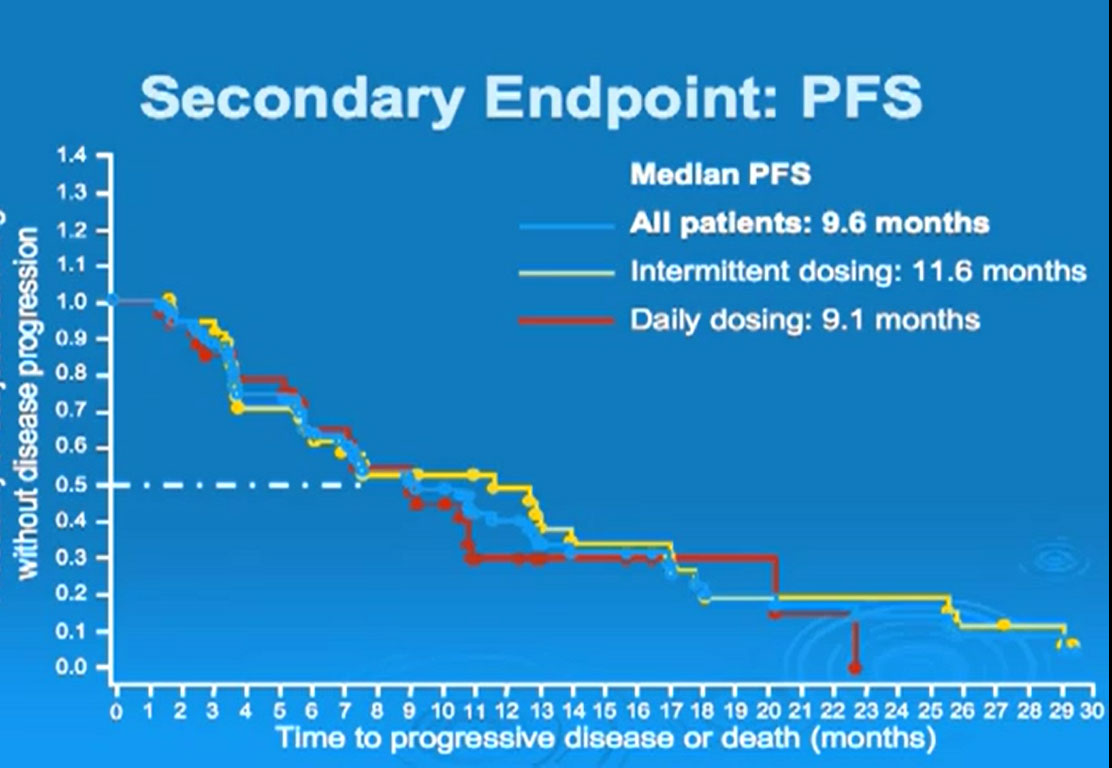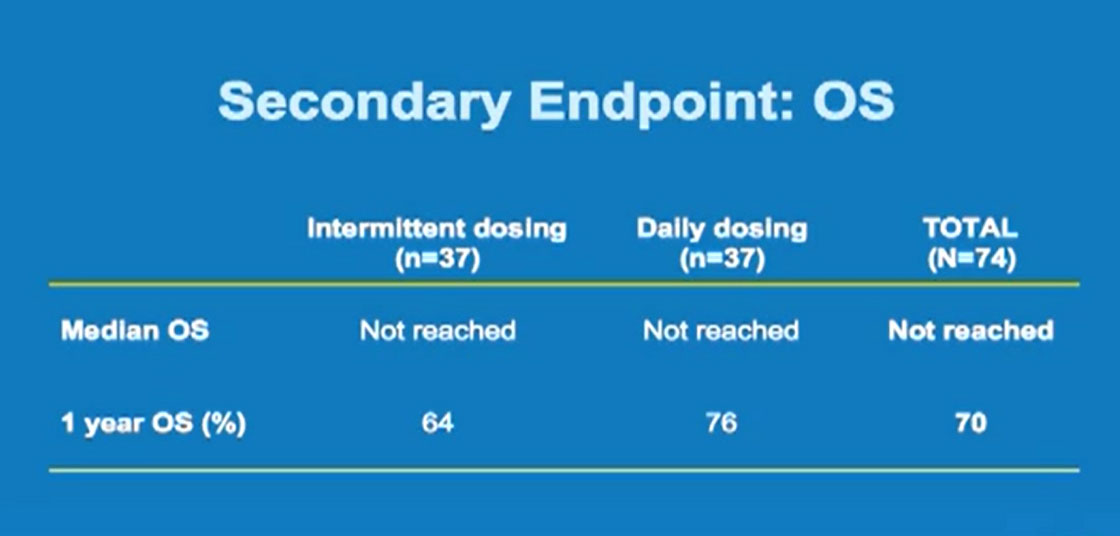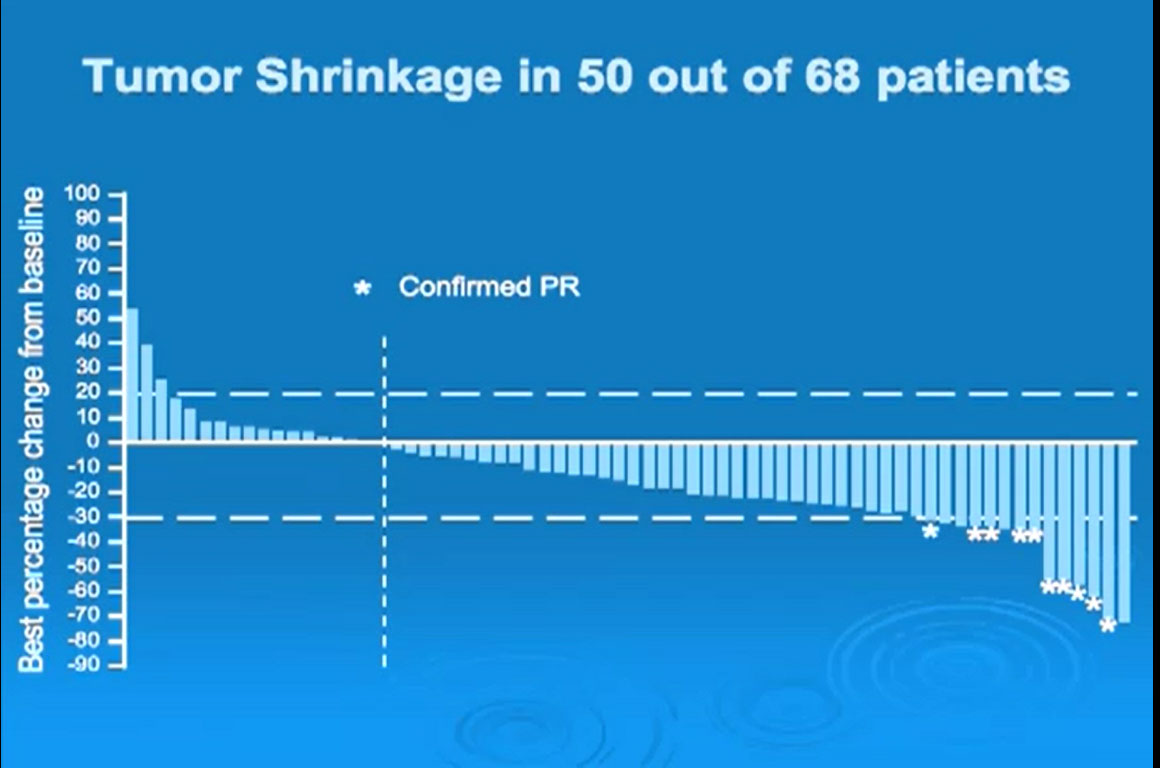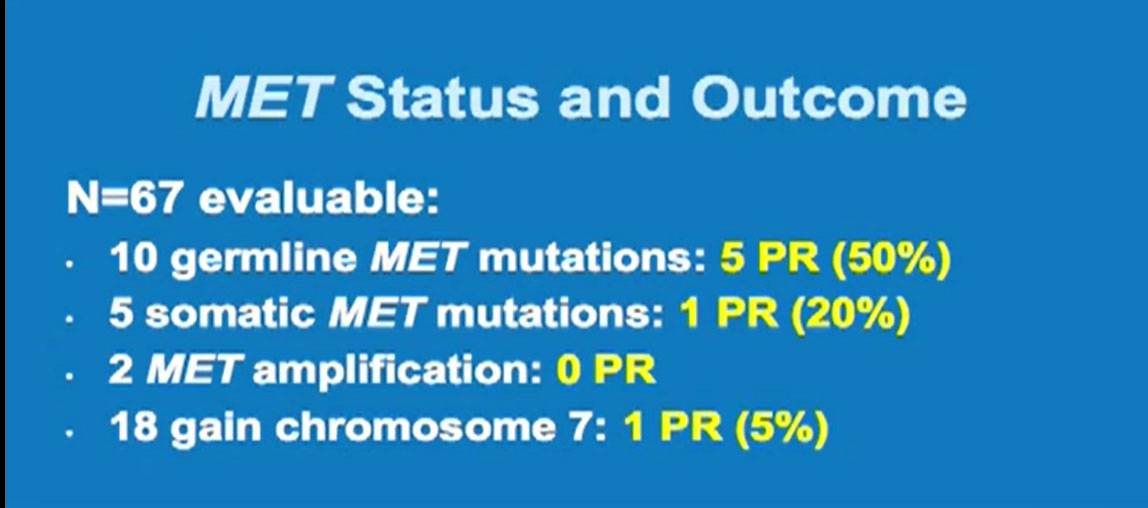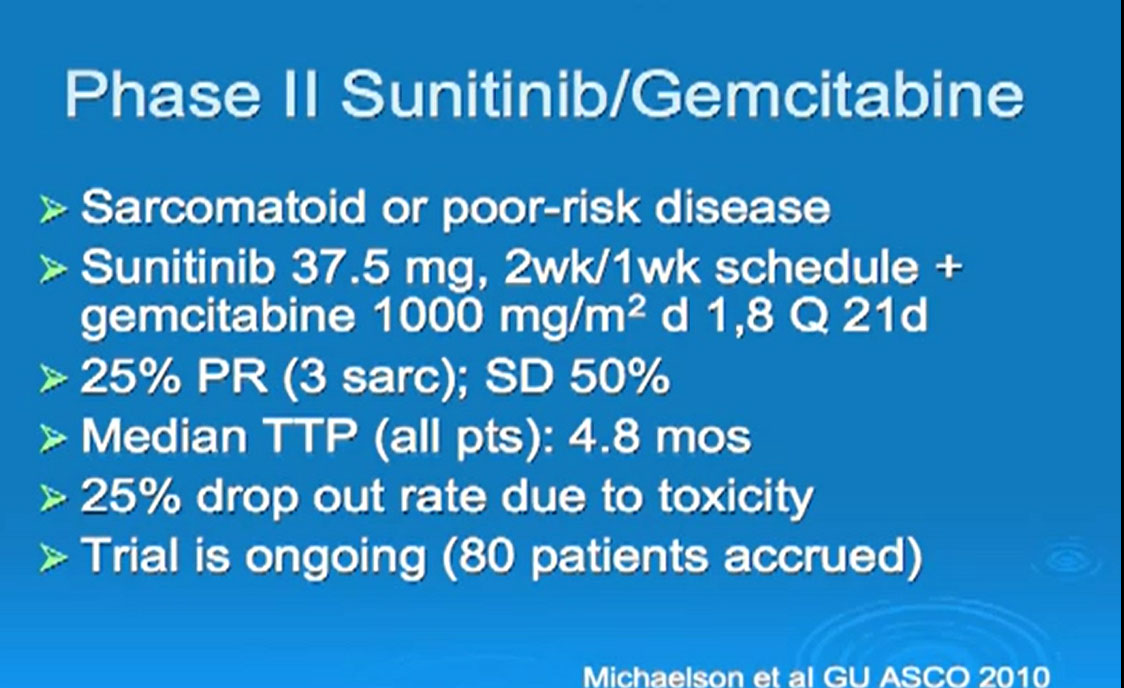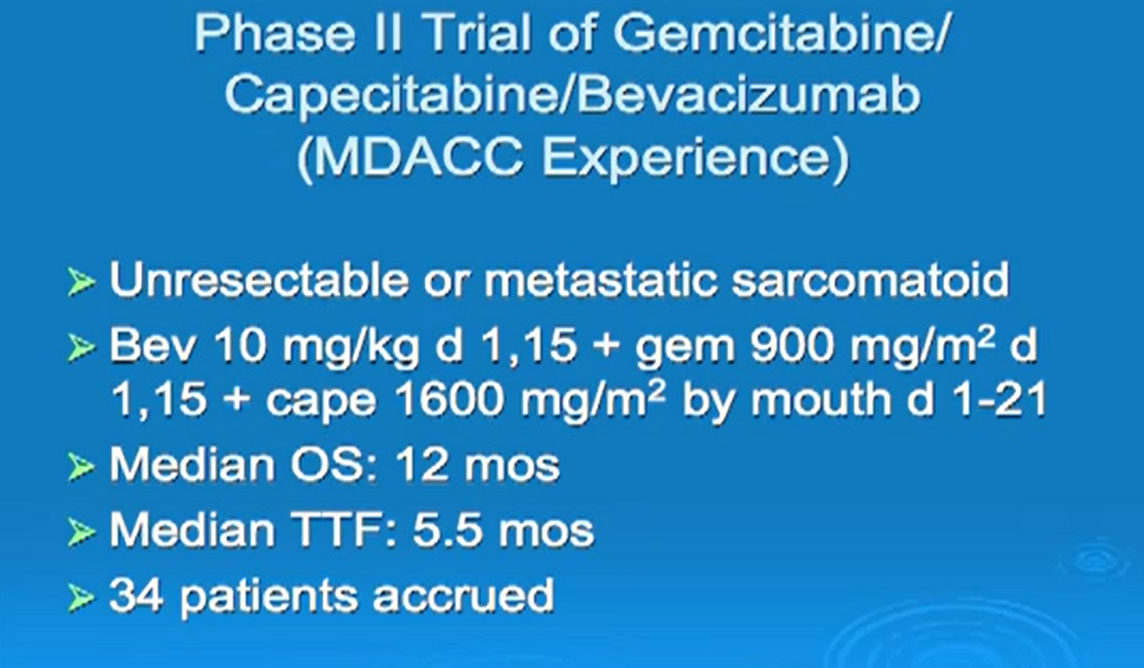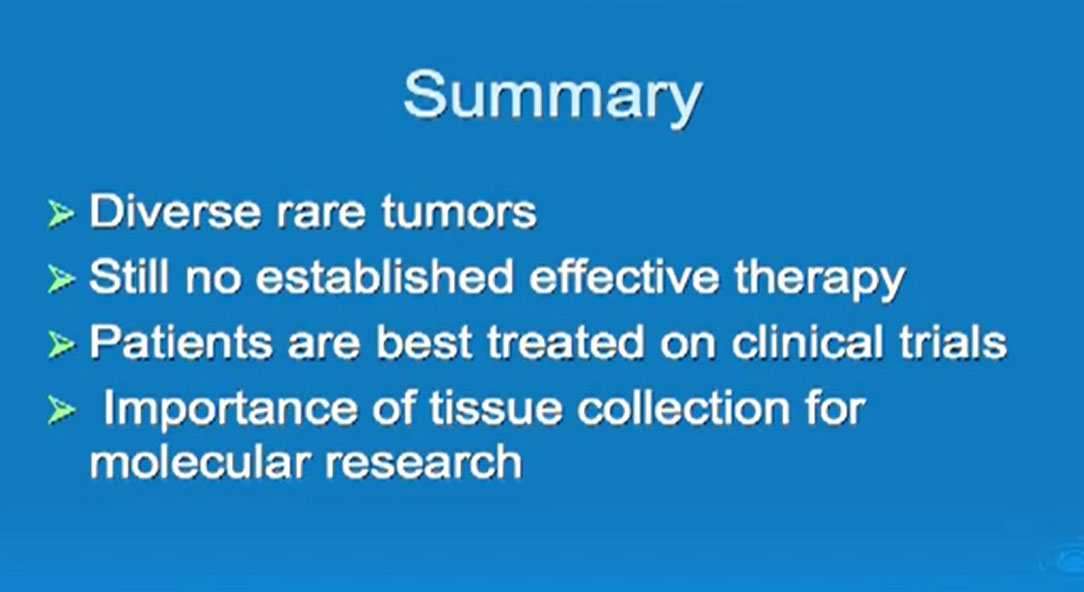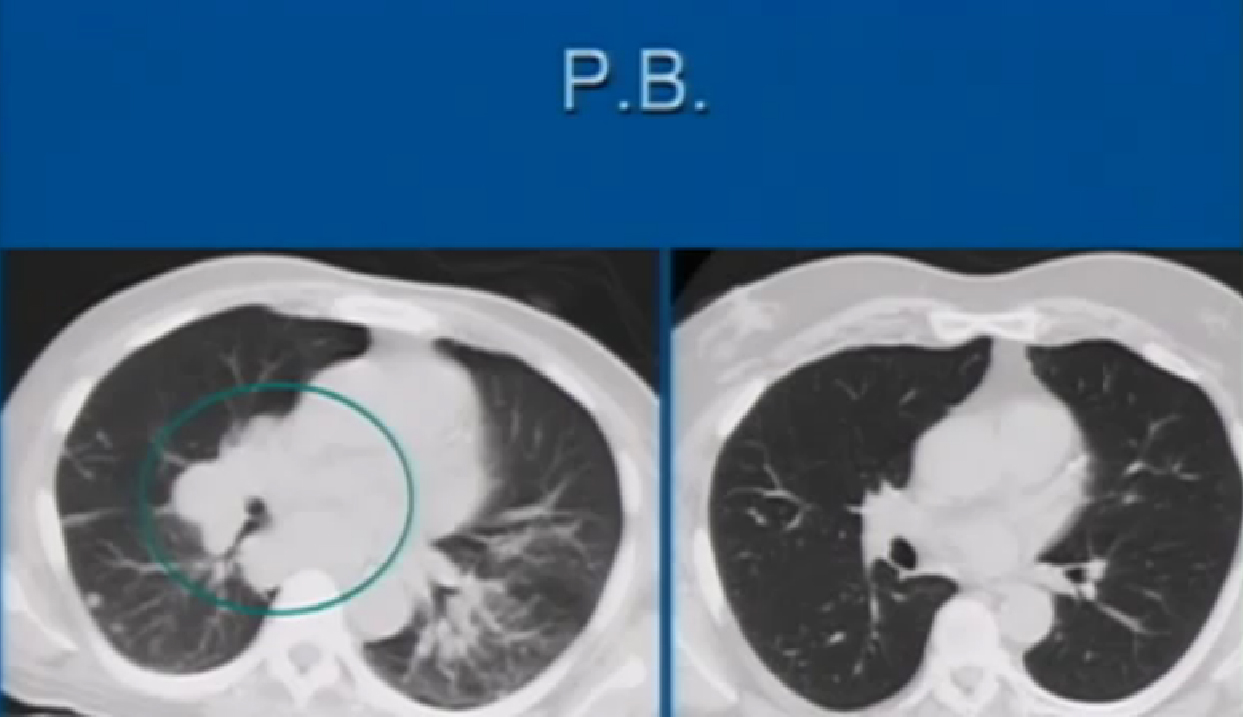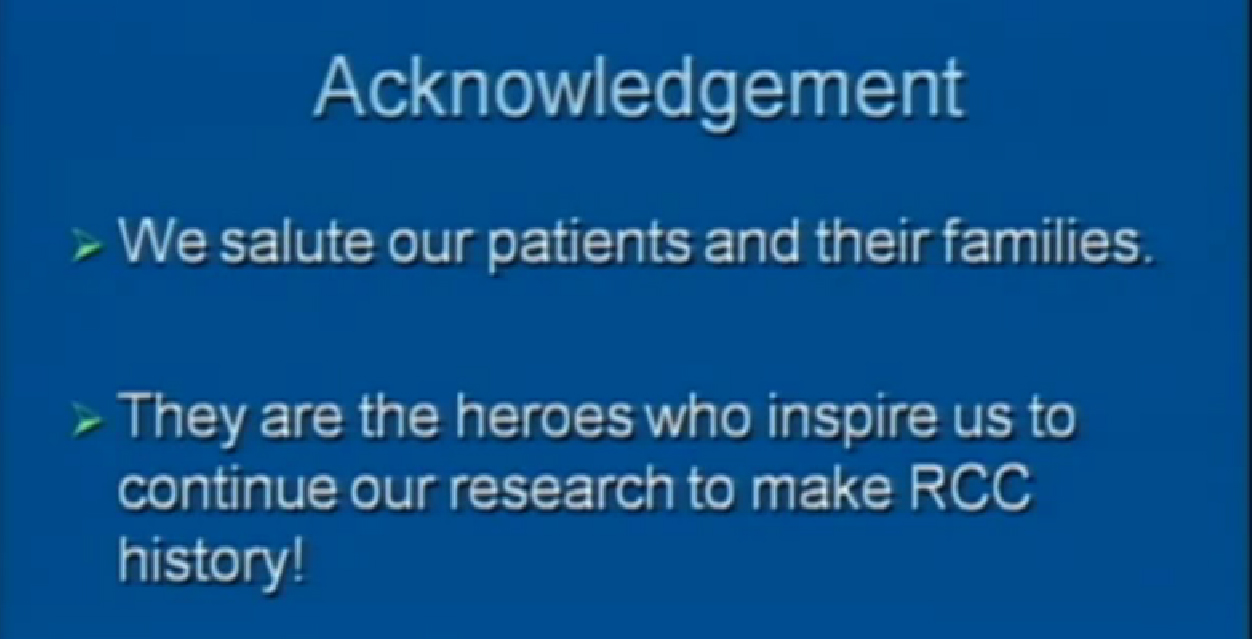Dr. Nizar Tannir, MD, FACP
Dept of Genitourinary Medical Oncology
University of Texas MDACC; KCA Patient Conference; April 14,2012
Treatment Options for Patients with Non-clear Cell Histology
Thank you all for coming, and thanks to the KCA for sponsoring this, which has become a yearly event. So why this talk? The short answer is that regrettably, most of the trials if not all, recruit patients with the conventional histology, that is clear cell RCC.
But up to 20% of advanced renal cell carcinoma patients have these rarer types. That is not one type of tumor, but a diverse group of tumors. It’s not one disease, but heterogeneous diseases. I’d like to show you what has been done so far, and a glimpse of hope going forward.
You heard this morning about conventional type clear cell renal carcinoma, the most conventional; about 75-80% of patients with advanced RCC have this type. But about 20% have these diverse histological subtypes, with papillary 1 & 2 considered about 15%. Of patients without metastatic disease, who get just a nephrectomy for a primary tumor, it is estimated that about 10% will have papillary type 2 and about 5% will have type 1.
In my experience, when patients have recurrence after a nephrectomy, or present with advanced disease at initial presentation, the majority have the type 2 papillary.
Chromophobe is less common than papillary, is indolent, is less aggressive, and it progresses more slowly than the other. But when it is metastatic, it is incurable.
Collecting duct is another aggressive type non clear cell RCC, and renal medullary is a very close type, very similar histologically. However, it is unique in that it affects African-Americans, typically at a young age, who have the sickle cell trait.
Translocation is a newly diagnosed, or a newly recognized entity that is mostly present in young people, adolescents and young adults. We are now conducting molecular research on this unique entity.
There will be about 5-7% patients who will have this report signed by the pathologist, classified as unclassified RCC. This is really a waste basket diagnosis, as it reflects our inability to pinpoint the diagnosis, so “unclassified”. As our molecular insights advance, we will be able to classify the unclassified into more unique and distinct types. There are some rare cases, mucinous tubular and and spindle cell, TS thyroid type. Oncocytoma is usually benign, rarely metastasizes but it is one of those non-clear cell types also.
I added sarcomatoid dedifferentiation because it presents challenges to the treatment of patients with this dedifferentiation. Sarcomatoid occurs with all subtypes of RCC, the conventional clear cell type and non clear cell type. It portrays an aggressive behavior.
This is what papillary Type 1 looks like this under the microscope. This is an inherited syndrome that is characterized by germline mutation of the c-MET oncogene. It is characterized by considerable activation of the c-MET receptor. It is estimated that about 10-15% that are sporadic that are reported as papillary type 1 will have this mutation in the tumor .
The other papillary type 2 is also an inherited syndrome, also characterized by the germline mutation of a tumor-suppressor gene, the fumarate hydratase gene. Individuals that have this, in addition to renal cell carcinoma, have leiomylomas. Females have leiomyomas of the uterus; both sexes will have leiomylomas of the skin. They are referred to as HLRCC hereditary leiomyoma RCC. Sporadic tumors are obviously much more common in type 1 and type2 papillary rcc and the molecular knowledge about this, the molecular characteristics are not well characterized.
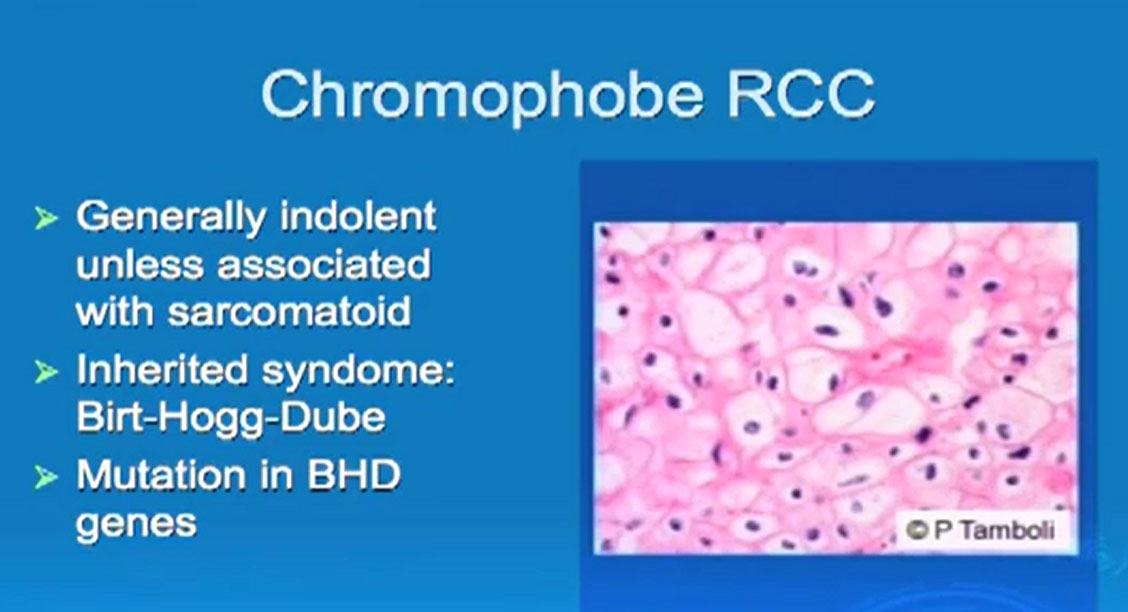 This is Chromophobe RCC; usually indolent, compared to the others, unless it is shown with saracomatoid features, and then it becomes virulent. There is an inherited syndrome associated with this, called Birt-Hogg-Dube syndrome, and there is a mutation in BHD genes: follicular is one of these.
This is Chromophobe RCC; usually indolent, compared to the others, unless it is shown with saracomatoid features, and then it becomes virulent. There is an inherited syndrome associated with this, called Birt-Hogg-Dube syndrome, and there is a mutation in BHD genes: follicular is one of these.
Collecting Duct carcinoma of the kidney is highly aggressive, and it is a disease hybrid between renal cell carcinoma and transitional cell carcinoma TCC of the pelvis, which behaves like bladder cancer. You will see features of the RCC and TCC in patients that have this tumor. It is invariably an aggressive type of cancer and invariably presents at an advanced state. Renal medullary RCC is very closely associated with collecting duct, and affects young African Americans with sickle cell trait.
This is what unclassified RCC looks like under the microscope; with refinement of our technology we will be able to sub classify more the unclassified.
Translocation RCC is typically a disease in young females. Patients, young women and adolescents often present with advanced disease, with extensive lymph node metastases. The TFE 3 protein product of translocation has been studied.
This is what the sarcomatoid RCC looks like, and again it is associated with both clear cell and non-clear cell RCC histologies. Chemotherapy plus targeted therapy trials are ongoing but prognosis remains guarded.
Outcome of Patients with Advanced nccRCC
This is historical data, from the pre-targeted therapy era, when chemotherapy, interferon and interleukin 2 were the mainstay of therapy of patients with RCC. This is a retrospective study from the Sloan Memorial in 64 patients with non-clear cell histologies. The majority were reported as having collecting duct, then chromophobe, papillary and then unclassified. The median survival was about 2 ½ years in patients with chromophobe RCC, but worse in patients with collecting duct and papillary, and very dismal median survival with advanced papillary. Again, this is pre-targeted therapy.
We look at our own experience. These Kaplan-Meier curves represent patients treated;, the ones here (on the upper line) were treated with conventional. This is group (on the lower line) with the non-clear cell, the non-conventional. Survival is about 10 months median with the non-clear cell vs patients with clear cell. Again, patients treated in the era of immunotherapy.
Current Therapy of Metastatic Non-clear Cell RCC
So what about the current therapy of patients now with advanced non-clear cell RCC? I think that you may already have heard about this earlier from speakers.
Temsirolimus was tested in patients in a phase III trial, with advanced poor-risk patients, with advanced RCC, and with multiple risk factors such as poor performance status, anemia, hypercalcemia, and high serum LDH. Patients were randomized to receive either Temsirolimus, the mTOR inhibitor given intravenously weekly versus interferon as a comparator, or the combination of these two. Survival was the primary endpoint of this study. Of these patients, 20% had non-clear cell RCC histologies. Results were in favor of Temsirolimus with a median survival of 10.9 months with Temsirolimus vs 7.3 months median survival treated with interferon. This is an improvement of 49%. So you can say that for patients with non-clear cell histologies with poor risk factors, that Temsirolimus is a reasonable option as first line therapy.
This is a retrospective study conducted and published by the French and Cleveland Clinic, with investigators looking at the Sunitinib and Sorafenib. (Sutent and Nexavar) The majority of these patients (41 or 77%) had papillary, and 12 or 23% of patients with Chromophobe. The take home message on this retrospective analysis is that there was no central pathology review to really confirm that in fact, these patients had the reported pathology. Also, there was no central independent radiology review to confirm the responses. But the investigators reported a decent median progression free survival in patients with papillary, 7.6 months, but obviously shorter than what we see in patients with conventional type RCC. For chromophobe, the median PFS was even better at 10.6 months. Retrospective studies and again, patient selection biases are inherent in this.
The French conducted a Phase II trial with Sunitinib in papillary RCC. The majority of these patients had type 2, the most frequent type of non-clear cell patients with advanced disease. They observed only one patient achieving a partial response, 1 among 23 with type 2. None of the five patients with Type 1 had a response.
The Sloan Memorial group published their experience. This was a single arm phase of the trial, but unfortunately was closed to patient accrual prematurely, due to slow accrual. That brings up the point about the importance of patients’ participating in clinical trials. If we don’t really have robust participation in trials, we end up with trials that take a long time and many of them close before the end point is realized. Thus we really cannot make robust claims about the results. But among 22 evaluable patients, 8 had papillary, 5 unclassified and 10 were reported as having others. Only one patient had a positive response; that was one with unclassified rcc. The median PFS was just 5.5 months, basically half of what we would expect with patients with conventional cell histology. In patients with papillary, the median progression free survival was 5.6 months.
We at MD Anderson conducted our own study with Sunitinib. With 57 patients, this is one of the larger Phase III trials of Sunitinib–or any targeted drug in non clear cell RCC. The median age was typical of trials, about 60. We have different risk groups, good, intermediate and poor. Two-thirds of our patients had prior nephrectomy and we allowed prior systemic therapy. Eight patients had prior systemic therapy. We did not exclude patients with brain metastases, if the brain metastases were controlled.
HISTOLOGIES
This is the breakdown of the different histologies of the patients involved in that trial, with papillary constituting about half of the patients, 27 of the 57. Eight had unclassified, 7 had sarcomatoid, 5 chromophobe, 4 renal medullary and 2 collecting duct.
And there was one each of these rarer tumors. (slide reads tubulocystic, translocation, thyroid-like follicular carcinoma and mucinous/tubular/spindle cell.)
This is a summary of the efficacy data with the median follow up of 21.7 months. We observed 5 responses, less than 10%. Two of these responses were in chromophobe 2 of 5, that is, 40 %. That seemed to mirror the experience with conventional histology, and there was one patient each that had response, 1 of 25 in papillary, 1of 8 unclassified, 1 of 7 sarcomatoid. The important point to mention about this trial is that all the slides–the pathology specimens–were reviewed by one GU pathologist and all the scans, baseline and subsequent scans throughout therapy were reviewed by a single, blinded radiologist. So we are pretty confident of these results we report here.
The progression free survival and the overall survival of this data are in this slide. For the 55 patients evaluable for response, the median PFS was 2.7 months, absolutely very disappointing. You can see that the confidence interval is quite narrow, meaning we think that this reflects reality. For the 25 patients with papillary RCC evaluable for response, two were not evaluable for response. The median response for PFS was 1.5 months, again, a narrow confidence level.
For all 57 patients, the median overall survival was 16.8 months, perhaps reflecting maybe patients lived longer because they received maybe some subsequent therapy that they benefited from more than they benefited from Sunitinib. For the patients with papillary RCC, the median overall survival was 12.5 months.
The progression free survival and the overall survival of this data are in this slide. For the 55 patients evaluable for response, the median PFS was 2.7 months, absolutely very disappointing. You can see that the confidence interval is quite narrow, meaning we think that this reflects reality. For the 25 patients with papillary RCC evaluable for response, two were not evaluable for response. The median response for PFS was 1.5 months, again, a narrow confidence level.
For all 57 patients, the median overall survival was 16.8 months, perhaps reflecting maybe patients lived longer because they received maybe some subsequent therapy that they benefited from more than they benefited from Sunitinib. For the patients with papillary RCC, the median overall survival was 12.5 months.
Phase II study of Everolimus in Advanced Papillary RCC (RAPTOR)
There is now an ongoing trial, the RAPTOR study, with Everolimus, the mTOR inhibitor mentioned earlier. It’s occurring in Europe at multiple sites, and is a single-arm study of Everolimus in patients with papillary RCC. The primary endpoint of the trial is progression free survival at 6 months, and secondary endpoints are disease control rate, objective response rate (ORR), and median progression free survival (PFS) and safety.
Randomized Phase II Trial of Everolimus vs Sunitinib
There are two phase II trials of Everolimus versus Sunitinib, led by Duke and recruiting patients from Canada and the United Kingdom and one of our own, led by our institution with contributions from the Harvard Consortium.
A Phase II trial of Everolimus vs Suntinib in Non-Clear Cell in MDACC
The two trials are very similar in design except the Duke study–the ESPEN trial–does ot have a cross-over at progression with first-line therapy. This is the schema of treatment of the trial ESPEN, with Everolimus vs Sunitinib in prospective evaluation with patients with non-clear cell RCC. Patients with non clear-cell RCC after stratification, whether they have papillary or the other non clear cell subtypes.
A Phase II trial of Everolimus vs Suntinib in Non-Clear Cell in MDACC
The two trials are very similar in design except the Duke study–the ESPEN trial–does ot have a cross-over at progression with first-line therapy. This is the schema of treatment of the trial ESPEN, with Everolimus vs Sunitinib in prospective evaluation with patients with non-clear cell RCC. Patients with non clear-cell RCC after stratification, whether they have papillary or the other non clear cell subtypes,will be randomized to receive either Everolimus 10 milligrams a day or Sunitinib at the standard dose and schedule, 50 mlgr/day, four weeks on, two weeks off. They stay on therapy until they have progressive disease. At progression, they cross over to the other agent that they did not receive as first-line therapy.
Therapy of Papillary RCC; A New Way Forward?
Now moving forward. I hope the future will be brighter than what I showed you. There are a couple of interesting trials that I would like to present to you, what hopefully what the future will bring.
EGFR is being recognized as an important pathway to block several malignancies, epithelial malignancies, and kidney cancer is one of them. Evidence for EGFR over-expression or aberrant function has been reported in many of these epithelial malignancies.
Rationale for EGFR Inhibition in RCC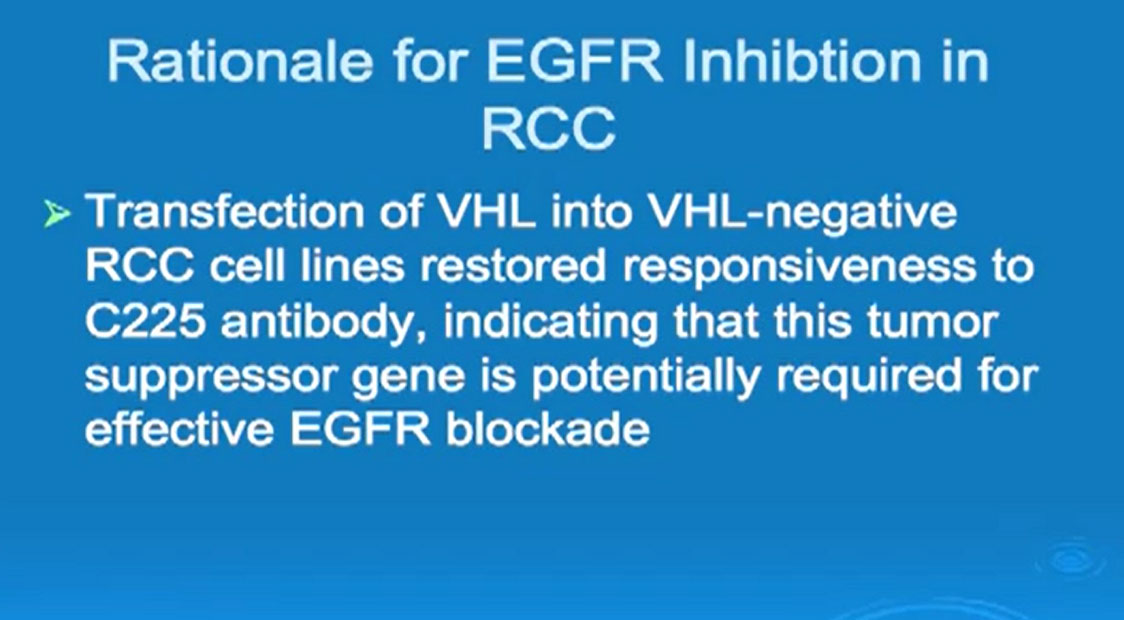
And there is a rationale for EGFR inhibition in RCC. This was from pre-clinical in vitro work in RCC cell lines. This was work done by Dr. Mendelsohn, our former president here, where they transfected VHL into VHL-negative cell lines and showed that restoration of the response to the antibody to against EGFR, the C225 antibody or Cetuximab was blocked the tumor growth, indicating that presence of wild-type VHL is required for effective EGFR blocking.
Phase II trial of Erlotinib in PRCC
That constituted the hypothesis for this Phase II trial, conducted by South West Oncology Group, published three years ago. They had 52 patients enrolled from 27 SWOG sites and 2 ECOG sites, seven of those 52 patients were ineligible for different reasons. Only 45 patients were evaluable.
Efficacy Median Follow Up
And this is the efficacy slide, with a median follow up of 21 months. There were 5 partial responders, four were confirmed, one unconfirmed. There was an 11% response rate with a wide confidence interval, as you see. (Wide confidence interval means less confidence in results)
Efficacy Second Endpoint OVERALL DISEASE
The overall disease control rate, a second endpoint of the study, and that included partial responders as well as patients with stable disease and this was 64%. The probability of freedom from progression or treatment failure at six months was 29%. The estimated fractions at 2, 4 and 6 months of patients who were stable or responding were 71%, 44% and 31%, respectively.
Overall Survival
Overall Survival at six months was estimated to be 87%, and median overall survival estimated to be 27 months. This is pretty encouraging, but again, a single-arm study of 45 patients, where you could bring up some patient-selection biases.
Study Limitations
These are the study limitations. They did not look at tumor grade. We know very well that papillary RCC is not one disease, as I mentioned and that patients with tumors which have high grade have more aggressive disease than patients with lower grade.
They also did not differentiate, did not characterize how many of those patients of the 45 recruited had Type I or Type II. There was no comment on what second-line therapy these patients might have received later after they received Erlotinib on this trial that could have confounded/compounded the survival and showed the survival to be better than what we have been accustomed to seeing. No mention of how many patients has prior nephrectomy or metastatectomy prior to enrollment in the trial. There was no correlation at all between EGFR expression with PFS or OS. And again, there were several patients who did not have central pathology review.
Erlotinib in RCC
As to Erlotinib in papillary RCC, Erlotinib appears to have some activity in papillary RCC. Overall, Erlotinib is a well-tolerated therapy, but is inhibition of this pathway beneficial to all patients with papillary RCC? That remains to be seen. Which subgroups of papillary would benefit most from the EGFR inhibitors? I think the story is similar to the story with non-small cell lung cancer, adenoma carcinoma of the lungs, where EGFR mutation has been linked to faster response among these patients. Which molecular markers will be predictive of response? We wait to see. Only through larger, prospective, randomized trials, will we be able to answer many of these questions. We need an ongoing, a future trial, looking again at Erlotinib (Tarceva) in patients with papillary RCC.
The C-MET Signaling Pathway
Now an interesting pathway is the C-Met pathway. This pathway seems to be operational, operative in some patients with papillary RCC. You see that hepatocyte growth factor is the ligand that signals through the receptors–the MET receptor–and causes down-stream effects. There are several agents in the clinic in phase I and Phase II that are targeting this pathway. This is an antibody (referencing AMG 102) against the hepatocyte growth factor, by AMGEN. There is another drug similar to this that targets the ligand, that is from AVEO and then there are several of this small molecule tyrokinase inhibitors that block the pathway here, intracellularly. I will focus now on one called Foretinib, XL880.
Phase II and Biomarker of the Dual MET/VEGFR-2 Inhibitor Foretinib in PRCC
This is a phase II trial that was conducted at multiple centers in the US. There was a biomarker initiative in this drug to study the effectiveness of the MET and how it was modulated and MET correlated with outcome.
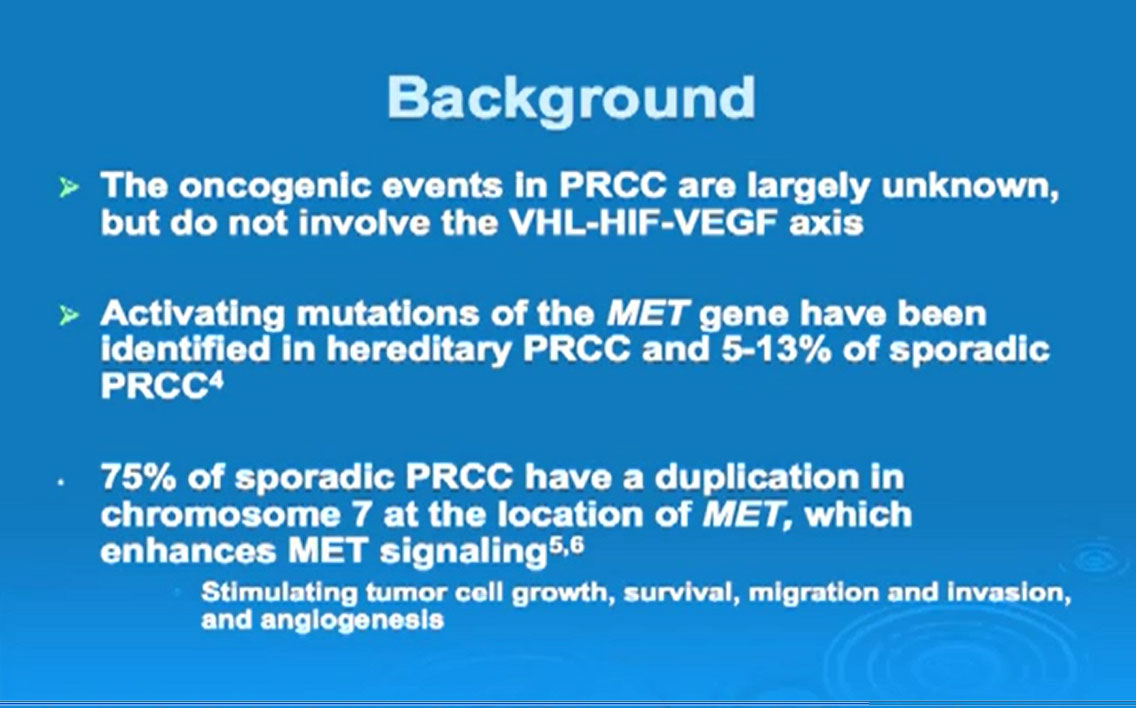 We have already covered that the oncogenic events in PRCC are unknown, but do not involve the VHL-HIF-VEGF axis. Activating mutations of the MET gene have been identified in hereditary PRCC and about 10% of sporadic PRCC. Seventy five percent of sporadic PRCC may have duplication in the chromosome 7, at the location of MET, which enhances MET signaling.
We have already covered that the oncogenic events in PRCC are unknown, but do not involve the VHL-HIF-VEGF axis. Activating mutations of the MET gene have been identified in hereditary PRCC and about 10% of sporadic PRCC. Seventy five percent of sporadic PRCC may have duplication in the chromosome 7, at the location of MET, which enhances MET signaling.
Foretinib
What is Foretinib? It is a multi-tyrokinase inhibitor, and predominately blocks two pathways that may be critical in patients with papillary RCC, the C-MET pathway and the VEGF-R2 pathway. It was shown to have activity in xenograph models and in a phase I trial, two patients with PRCC had a durable partial response. One lasted more than forty-eight months. Based and encouraged by this, and on the rationale of blocking the MET pathway in papillary RCC, a phase II trial was then conducted.
This is the study design, the treatment plan for Foretinib. There were two dosing cohorts, one intermittent with 240 milligrams a day, given every five days for two weeks, and a daily dosing of 80 milligrams a day. The important thing about this design and its design in this trial is that patients were stratified by whether they had evidence of germline mutation of the MET oncogene or if they had other MET pathway aberrations such as somatic MET mutation, or duplication of chromosome 7 and/or 7q31 amplification. The study was designed to have at least 30 patients per dosing cohort.
Study Endpoints
The primary endpoint was objective response rate, and the secondary endpoints included progression free survival, overall survival, safety and tolerability and pharmacokinetic and pharmocodynamic markers, and the correlation of the MET status with outcome.
Primary Endpoint ORR
This is a summary of the efficacy, looking at the objective response rate. Thirteen point five percent had partial response; it was the same with the two cohorts, with intermittent dosing or daily dosing. Duration of the response was a year and a half, and 88% of the patients had disease stability, either partial response or stable.
Secondary Endpoint: PFS
Looking at the Kaplan-Meier curves of progression free survival, we see in blue the overall cohort of 74 patients, in yellow those receiving intermittent dosing and in red the patients treated with daily dosing. As you can see, compared to what we discussed earlier with Sunitinib and others, this is very encouraging, to have nine months of progression free survival in these patients.
Secondary Endpoint Overall Survival
In this slide of secondary endpoints, the median is not reached across both cohorts, and about 70% of patients were alive at one year.
Tumor Shrinkage in 50 Out of 68 Patients
This is a waterfall plot on the right, showing best % change of tumor from baseline. You see that 50 of 68 of patients had tumor shrinkage. Even though the response rate was low and did not meet the primary endpoint that the investigators set, fixed at 25% to make it more interesting and move forward with this drug, but at 13.5% , this was about half of what they aimed at. When you look at the tumor shrinkage, I think this is impressive to see this in a disease where we have no established therapy.
MET Status and Outcome
Now I think this is very important slide, as it illustrates a proof of concept, that when you target a particular pathway that drives the disease such as the type I where you have the germline MET mutation, five of ten patients, that is 50%, had partial responses. When you look at sporadic cases, only one of the five or 20% of those with the sporadic MET mutation had partial response, and the others did not respond. So I think this represents a progress, a map forward, to try to bring this company to sponsor a large trial, testing this in a large number of patients.
I told you I would mention sarcomatoid because it presents challenges to our management of sarcomatoid RCC.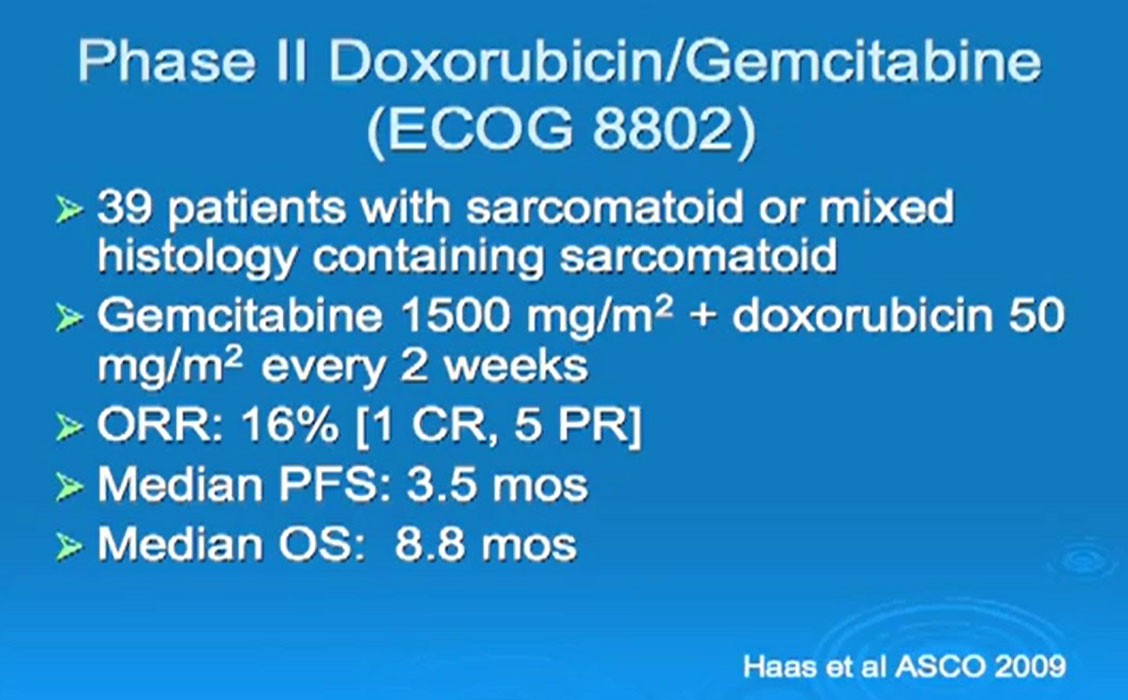
Phase II Doxorubincin/Gemcitabine
Just briefly, the backbone of treatment for sarcomatoid treatment remains chemotherapy. People have looked at adding target therapy. This is the backbone of the treatment, two cytotoxics. In this trial conducted by ECOG, published in Medical Oncology Journal lately, the response rate and efficacy were not very encouraging. Median PFS, less than four months, median overall survival, less than nine months with chemotherapy for these patients.
Phase II Sunitinib/Gemcitabine
There is an ongoing trial at the Harvard Consortium, looking at combining Sunitinib with Gemcitabine in patients with either sarcomatoid RCC, or poor risk disease. This was presented with preliminary results two years at ASCO GU. There was a 25% partial response in 3 patients, but again looking at the time to progression of 4.8 months and then there was a high toxicity, with 25% of patients dropping due to high toxicity. This is ongoing with a total of 80 patients accrued on this trial.
Phase II Trial of Gemcitabine/Capecitabine/Bevacizumab at MDACC
This is our own experience on this trial. We just recently closed this trial with 34 patients accrued, combining Gemcitabine and Capecitabine, two cytotoxics with Bevacizumab, a targeted agent blocking VGEF. Again, our results are in keeping, in the ballpark with other trials.
Summary
In summary, non-clear cell renal cell carcinoma presents diverse rare tumors, and unfortunately, still we have no established effective therapy. This is why I believe that patients with advanced non-clear cell RCC would be best treated on clinical trials, as I believe you heard Dr. McDermott say earlier. There is no place where this is more urgent than patients with non-clear cell RCC, because the other FDA-approved treatments that work with conventional clear cell cancer, unfortunately do not work as well in non-clear cell. But the point the importance of collecting tissue. This is crucial to advance our knowledge.
Pedro
I want to finish with a glimmer of hope as I always try to in these presentations, where we don’t always have that much good news. This is one of my patients from ten years ago. This patient had a conventional cell carcinoma with sarcomatoid, had his surgery in the Valley, came two months after his surgery with metastases to bones, lungs, and lymph nodes. I show you this scan of Pedro. Pedro came in with a large family, 15 members, in a wheel chair. He had compromised performance status, required transfusions weekly, he had constitutional symptoms, with weight loss and sweating. This was ten years ago when we did not have any of these therapies.
Pedro wanted to be treated, his family supported him and we treated him with what we had at the time. That was chemotherapy with F/U, Gemcitabine, and low dose interferon. As you can see from this slide scan to the right, from recently, Pedro is alive and doing well in complete response, ten years later. He is celebrating ten years’ anniversary beating kidney cancer with his family.
Acknowledgement
We salute you, the patients and the families. You are the heroes who inspire us to continue our research to make RCC a history. Thank you. (said with great emotion)
Questions from the audience follow:
I want to say it is good to see some of you, patients of mine and families, you inspire us. I want especially to mention Teresa and Matt. We wish you all the best. Matt keeps me updated; he is my best source as to what is going on in the world, whether it is on Wall Street or any countries. I am going to ask him to join our research group, we need people who are motivated, and there is nothing better than the spouse and the patients. So I hope
that our partnering, academic centers and people like you, the patients and families –I think we can partner and be a force to push Congress, to push the drug companies to support, to bring in new drugs, new therapies, that we badly need for our patients.
Matt: I appreciate your efforts, Dr. Tannir, and any help with papillary would be great, and XL880 is stuck in limbo and XL 184 I think represents a lot of promise for papillary and also clear cell, in making those medications, making them available for our patient group, for patients with clinical trials and off label, where they are approved for other types of cancer.
Tannir; “I don’t want to forget that when we partner, also with insurance companies, because I know you, many of you struggle. I’ve had patients with papillary, as Matt mentioned, and there are no clinical trials available right now, and they reject that, and I think that is unfortunate that insurance companies. This now politics, but insurance companies, when you have gone through all the standards of care, you think that there is drug that might help them and they deny that. But I think that we can, by joining forces, that we can hopefully make that important change.
See you next year, and keep fighting!”

